Janice Horton's Blog, page 6
July 23, 2024
Travel Light – Hand Luggage Only
I’m now a great believer in pack less and travel light with no checked luggage and just a cabin bag and a personal item as hand luggage.
It’s been ten fabulous years since the backpacking husband and I sold everything we owned to travel the world long term and nomadically.
Ten years since I became an empty-nester and ex-housewife and we downsized all our possessions to slowly and gradually become minimalists.
I say slowly, because I laugh now when I see the photo below taken at Glasgow airport in 2014.
This photo was taken as we first set off as nomads on an extended trip via the USA and Central America, to a small Caribbean island where we planned to spend three months.
But just look at that huge pile of suitcases!
 Glasgow airport 2014 – so much luggage!
Glasgow airport 2014 – so much luggage!TABLE OF CONTENTS
SO MUCH LUGGAGE!HARD CORE SUITCASESHARD CASE HARD CORE LUGGAGE!THE BACKPACKING HOUSEWIFE!STILL SO FAR FROM BEING MINIMALISTSWHEELED BACKPACKSPACKING AND TRAVELLING AGAINHAND LUGGAGE ONLYTRAVEL LIGHT PACKING TIPSIS IT DIFFICULT TO TRAVEL LIGHT?TRAVEL LIGHT – TEN PACKING TIPSTHREE COMPELLING REASONS TO TRAVEL LIGHTMY TRAVEL LIGHT PACKING LISTTRAVELLING LIGHT – WHAT HAVE I LEARNED? SO MUCH LUGGAGE!Granted, the backpacking husband did have a lot of dive gear with him.
He planned to do lots of scuba diving and a PADI Dive Master Internship.
And, in my suitcases, I had lots of beach clothes and a tonne of torches and sprays and creams and bug zappers, and everything I thought I needed to live on a Caribbean island with sporadic electricity supply and lots of biting flies!
 HARD CORE SUITCASES
HARD CORE SUITCASES
For our next big trip – spending eight months in Central America and the USA and Canada – for some reason I decided we needed to upgrade our suitcases.
I did lots of research on finding the toughest hard-shell and hard core and indestructible luggage as possible.
I bought two from DELSEY SUITCASES and I guess I was hoping they’d be future proof and last all our future travels.
And so, for the next two years, we lugged those big heavy and fabulous suitcases from Europe across to the Caribbean and The Americas then all across Asia and the Pacific from Beijing to San Francisco and across the USA and Canada before heading back over the Atlantic and back to the UK having circumnavigated the whole world!
We learned a lot about travelling and about ourselves on that trip.
But not necessarily how to travel light.
Hard case hard core luggage!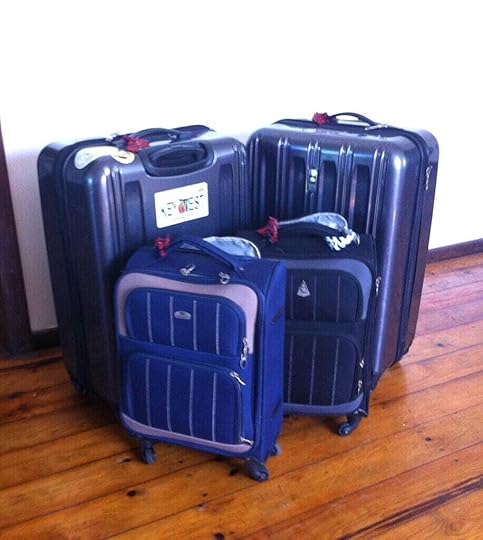 By 2015 I’d found the toughest hard case & hard core luggage for world travel
THE BACKPACKING HOUSEWIFE!
By 2015 I’d found the toughest hard case & hard core luggage for world travel
THE BACKPACKING HOUSEWIFE!
Because for the next world adventure – setting off from London to Bangkok – we decided that we needed to ditch the suitcases and buy backpacks to facilitate a lot of travelling and wrangling about in boats and island hopping.
Yay! The Backpacking Housewife was born!
Except, back then, I was still packing everything bar the proverbial kitchen sink.
And all my worldly goods were carried on my poor aging back.
I could hardly take the weight of my backpack even when using my daypack as a ballast.
Look at the size of those backpacks!!
 By 2017 we’d ditched the heavy suitcases and bought backpacks
STILL SO FAR FROM BEING MINIMALISTS
By 2017 we’d ditched the heavy suitcases and bought backpacks
STILL SO FAR FROM BEING MINIMALISTS
Through necessity, we started making hard choices about how many clothes, gadgets, toiletries, and other stuff we thought we needed.
And we learned the hard way because we started leaving stuff behind us as we travelled.
But we were still so far from being minimalists.
I justified this by saying that everything we owned in the world travelled with us.
I’ve heard it said that we ‘carry our fears’ with us when we start to travel.
“If you wish to travel far and fast, travel light. Take off all your envies, jealousies, unforgiveness, selfishness and fears.” Cesare Pavese.
I must have feared running out of clothes and shoes and toiletries!
 Waiting with our backpacks for a longtail boat in Krabi Thailand
Waiting with our backpacks for a longtail boat in Krabi ThailandThe backpacking husband, who was doing professional scuba diver training as we travelled, carried a lot of dive gear with him.
I don’t scuba dive but I really enjoy snorkelling, so back then I always had a full-face snorkel mask and fins and my water shoes with me, but later found out that you can often rent these things at your destination anyway.

That fabulous trip around Asia with our backpacks – exploring lots of Thailand and Malaysia and Philippines and Indonesia – ended up taking up two whole years.
It was the longest we were away from family and friends back in the UK.
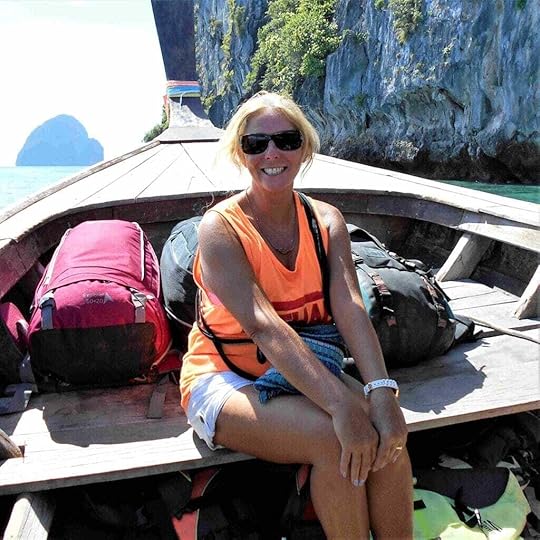 On the Andaman Sea Thailand with our backpacks
On the Andaman Sea Thailand with our backpacksAlthough, one of our sons lives in South Korea with his family, so we were able to see him several times and we spent quality time together.
Luckily, our other two sons and a few of our friends from the UK came out to join us for holidays in South Korea and Thailand and Malaysia.
Eventually, we got rid of those heavy backpacks and bought large and medium soft sided backpacks with wheels.
 Soft Sided Backpacks with Wheels and a Daypack
Soft Sided Backpacks with Wheels and a Daypack Setting Off Again With Wheeled Backpacks
WHEELED BACKPACKS
Setting Off Again With Wheeled Backpacks
WHEELED BACKPACKS
Wheeled backpacks, especially as we were both now in our late 50s, are a fabulous backpacking compromise.
You might like to read a more detailed post I wrote on Backpacks or Suitcases?
At last, after eight fabulous years of travel with heavy suitcases and overloaded backpacks, we were finally making progress in finding ways to lighten our load.
The backpacking husband had gained his professional dive qualifications and so no longer needed to carry all his heavy PADI Dive Manuals everywhere – they are all online now but back then they weren’t – and he also decided he could leave some of his gear back in the Caribbean at the dive centre there.
Then in 2020 the pandemic happened.
On that fateful day when all Trans-Atlantic flights were cancelled, we were at Heathrow Airport in London, awaiting for our flight to the USA and onto Honduras Central America and back to our favourite island in the Caribbean.
In a panic, we managed to contact a friend who had a holiday home in Scotland that we’d rented a couple of times before, to ask if he could make it available for us again.
Thankfully he did and so, feeling shocked and uncertain, we headed back to Scotland to wait it out.
PACKING AND TRAVELLING AGAINTwo years later, we were grateful to have found a safe haven, but we were also desperate to travel again.
We’d found it very hard to settle back into living in one place for so long.
And we hadn’t exactly needed a travel ban to prove a nomadic life suited us.
So, as soon as we could – in late February 2022 – in freezing cold weather and heavy snow, we headed to Glasgow airport.
We had our Covid vaccine certificates but at that time we also needed to take a Covid test at the airport to prove we were fit to travel.
And, exactly two years on, we thankfully resumed our journey back to the Caribbean.
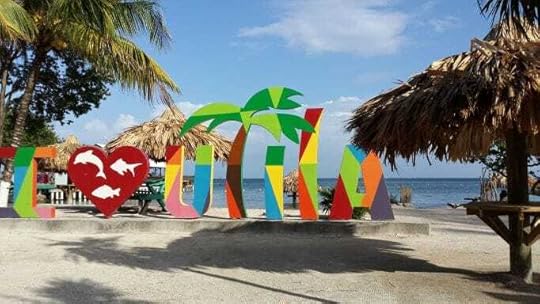 February 2022 we headed back to our favourite island in the Caribbean
A Grand Six Month Trip To Asia
February 2022 we headed back to our favourite island in the Caribbean
A Grand Six Month Trip To Asia
Six fabulous months later, at the end of August 2022, we arrived back in the UK to see family and friends before heading over to France on a three-month housesitting assignment.
Housesitting (mostly in France) is something we have done many times and over our many years of travel to allow for some downtime and to save money between our travels.
While in France, we made new future plans for A Grand Six Month Trip To Asia.
We wanted to visit our son and his family in South Korea.
We also wanted to see all the exciting places and explore all the countries that were still on our travel wish list like Japan and Taiwan and to revisit and to travel more extensively in Vietnam and Malaysia and Thailand too.
 While in France we made plans for A Grand Six Month Trip To Asia
While in France we made plans for A Grand Six Month Trip To AsiaAnd, once our itinerary was planned, and we saw this meant one long haul flight from London to Singapore and then lots and lots of onward travels by planes, trains, busses, large ferries, small boats.
We knew there was no way we were going to manage all that with heavy luggage!
Plus, in using the cheapest economy flights we could find, checking in luggage would have added considerably to our tightly controlled transport budget.
HAND LUGGAGE ONLYWe researched the exact dimensions of one of the least generous airline carrier’s free baggage allowance and sourced our new hand luggage to suit.
Air Asia, for example, allows one cabin bag of max: 56cm x 36cm x 20cm.
Plus a personal item of a handbag or laptop bag.
We bought a personal item sized backpack each – I chose a small backpack as of course I’m still the backpacking housewife – and a small hardcase wheeled cabin bag to Air Asia’s maximum cabin bag dimensions.
However, we weren’t only restricted by size as weight was also an issue.
As many airlines only allow a combined weight of 7kg for cabin baggage.
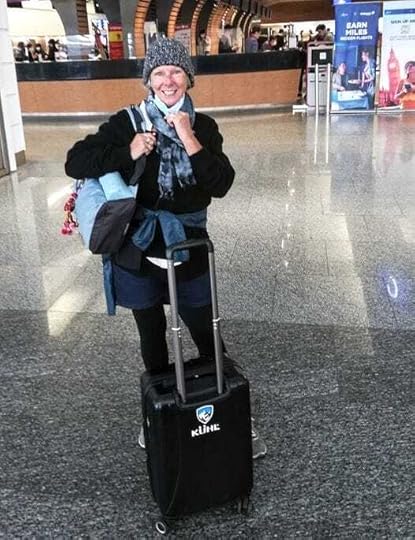 Wearing heavier and bulkier items to save space
Wearing heavier and bulkier items to save spaceSo at the airport we often wore our heaviest or bulkiest items to save space and weight.
And we both constantly struggle with the weight of gadgets but they get priority over clothes I’m afraid!
I use a lightweight laptop and the backpacking husband uses a tablet.
And of course we might not need a home but we do need a phone!
I recommend a duel-SIM unlocked worldwide phone so you can buy and use it with a SIM at your destination,
 Six Months of Travel – Hand Luggage Only
TRAVEL LIGHT PACKING TIPS
Six Months of Travel – Hand Luggage Only
TRAVEL LIGHT PACKING TIPS
I find rolling clothes and outfits together helps to organise and lessen creases.
I don’t use packing cubes as I feel this is extra weight.
I do use plastic zip lock food bags to organise items like charge cables etc.
No PJs needed as I often sleep in vest and yoga shorts.
I like to stick with a colour theme for my clothes so they mix/match.
Light cotton day dresses can also be worn over a bikini as a beach dress.
A longer dress and a shirt with sleeves are often required at temples and religious sites in Asia.
A sarong can also be used as a long skirt or a shawl.
For travel days in hot countries, I often like to wear light cotton ‘playsuits’, as they combine a top and shorts or a blouse and pants (trousers).
I never bother taking a towel as it’s usually supplied by accommodations.
I buy toiletries and sunscreen and bug repellent at my destination.
I don’t have any valuable jewellery. I like to wear simple trinkets.
Travel with a small digital luggage scale to check your luggage weight as you go.
IS IT DIFFICULT TO TRAVEL LIGHT?On occasion, it is difficult to manage with so little, especially the time we went to South Korea in December and again in February because it was freezing cold.
It was actually snowing when we arrived in Seoul and we didn’t have warm coats.
We had to go from the airport into Seoul by train and then take the KTX (Bullet Train) south to the City of Daegu and all the way I shivered and had coat envy!
I managed to buy and also to borrow some warm clothes for the time we were in South Korea.
Many of my clothes are from a thrift store or bought online and second hand anyway.
My Skecher trainers were bought online and are second hand but hardly worn.
Although, I bought my lovely comfortable Reef flipflops new in the half-price sale.
If clothes wear out or get damaged I can usually easily and cheaply replace them.
And think of all the money saved by not having to pay for checked luggage!
 TRAVEL LIGHT – TEN PACKING TIPS
TRAVEL LIGHT – TEN PACKING TIPS
1. Choose the Right Bag: Check the cabin bag regulations for your airline and exact specifications for your flight.
Make sure your carry-on-sized suitcase or a travel backpack to meet with the strictest sizes if you are flying with more than one airline.
Choose a lightweight but durable bag to avoid unnecessary weight.
2. Pack Versatile Clothing: When limited by size and weight you are forced to prioritise what you carry.
Take clothes in neutral colours that can be mixed and matched to create multiple outfits.
I use layers for warmth instead of bulky items.
I choose items that can serve multiple functions, like a sarong that can double as a blanket or sarong or even a skirt.
3. Limit Shoes: I never travel with more than two pairs of footwear.
Typically, I travel in my comfortable but bulky to pack trainers and take a pair of flat sandals or flip flops for alternative use.
4. Get Organised: I prefer to use zip lock plastic bags (food bags) to keep things like trinkets and cables and small items organised in my luggage. I find you can flatten them and squeeze the air out creating a compression bag to help reduce volume and space.
But I do know some travellers who advocate packing cubes.
5. Pack Light Toiletries: I like to use travel-sized bottles and transfer my favourite products into smaller containers.
Also consider using solid toiletries like shampoo bars which are lighter and take up less space.
Only bring essentials as most hotels provide basic toiletries and you can buy items as needed.
6. Minimize Gadgets: It helps if you can use your devices in multiple ways.
For example, I use my phone as a camera.
Take only essential electronics and chargers.
Pack a universal power adapter and a power bank for charging off grid.
I wouldn’t be without my stylish and fast charging Gomi Power Bank.
7. Do Laundry: I like to choose accommodations with laundry facilities or I’ll do laundry in the sink.
Pack clothes made from quick-dry materials to make washing and drying easier.
8. Organize Documents: Travel with only necessary physical copies such as your passport and a few backup printouts of essential information like your travel insurance details.
Store important documents like tickets, itineraries, and maps on your phone or cloud storage.
Make sure your next of kin have access to your important documents in your cloud storage or any other way that suits so that you have independent backups in an emergency or loss or should the need arise.
9. Leave Room for Souvenirs: Leave some space in your bag for items or gifts you might pick up during your trip.
I’m not really a souvenir person but on my last trip I bought a silk scarf for my mum and some shell bracelets for friends I knew I’d be seeing on my next trip.
A small foldaway cotton bag can be used for shopping and saves using plastic.
10. Review and Edit: Before you close your bag, go through everything one last time in case you can remove anything that seems unnecessary or redundant.
Use your small digital luggage scale to weigh your bag once again to make sure you meet airline requirements and that it isn’t too heavy to carry comfortably.
 Travelling Light
THREE COMPELLING REASONS TO TRAVEL LIGHT
Travelling Light
THREE COMPELLING REASONS TO TRAVEL LIGHT
1. Convenience and Mobility: This is the number one reason for us to travel light is because light luggage is simply easier to carry.
Lighter bags are more comfortable and your back and shoulders will thank you.
This in turn makes travel so much easier because you are able to move more freely and take spontaneous detours or to walk longer distances without being burdened by heavy bags.
Especially through crowded airports, train stations, or getting onto ferries or climbing into longtail boats while island hopping in Thailand.
It’s also very helpful not to be hauling heavy suitcases when your hostel or hotel room is on an upper floor and there’s no lift.
This number one reason alone promotes a good feeling about adopting a minimalist mindset and travelling light.
2. Cost Savings: The number two reason for us deciding to travel light was to avoid paying the extra charges for checked baggage on budget flights.
Traveling with a carry-on helps to avoid these fees.
Plus less weight on planes, trains, and automobiles can contribute to lower fuel consumption and a smaller carbon footprint which can be better for the environment and this also promotes a good feeling.
In carrying less luggage it’s also easier and more feasible to use public transport to and from your destination rather than needing to take expensive taxis.
3. Time Efficiency: And I feel the number three reason is to benefit from less stress and faster check in times at airports because with hand luggage only you can head straight through to security and then to your gate.
You can also bypass the baggage claim area upon arrival.
Packing and unpacking is much simpler when you have fewer items to manage.
Fewer belongings also means you have less to worry about and to keep track of and this reduces stress and the risk of losing items or having things stolen.

MY TRAVEL LIGHT PACKING LIST
This is what I packed for six months of travel in Asia!
Travel Clothes: Underwear. Vest. Black Leggings. Cotton Socks. Skechers Trainers. Denim Kuhl Shorts and Kuhl Cotton Shirt. Black V-Neck Wool Sweater.
On My Person: Passport. Phone. Credit Cards. Cash. Any trinkets/rings/watch.
In My Small Backpack: Foldaway rain jacket. One outfit (usually a light dress plus underwear). I pair Reef flipflops. Bikini. A cotton sarong doubles as a scarf or blanket. Small plastic bag containing various 100ml toiletries. Toothbrush. Reading Glasses. Sunglasses. Small cotton bucket hat.
Also My Essential Gadgets: Small laptop. Gomi Power Bank. Cables/Leads. Plug Adapter. Kindle (Ereader). Small Walkman (Music). Earbuds. Refillable Water Bottle. Small digital luggage weigher.
In My Wheeled Cabin Bag: 3 sets underwear. 1 x socks. Bikini. Sarong. 1 x rash vest (for sun protection/snorkelling). 2 x Vest Tops. 2 x Yoga Shorts. 1 x White Cotton Shorts. 1 x TShirt. 2 x Day Dresses. 1 x Longer Dress. 2 x All-In-One shorts and one longer leg set. Small purse containing mini first aid kit of paracetamol & travel sickness pills & similar meds, safety pins, plasters.
TRAVELLING LIGHT – WHAT HAVE I LEARNED?Our six months of travel with hand luggage only was a great success and I will not now travel any other way.
I have truly grasped and understood and embraced minimalism at last!
And I feel my life is richer for it.
I discovered that with few possessions there is less to worry about.
Less worry equals less stress.
And less stress equals freedom and happiness.
I finally realised that I’d once measured my own self-worth in material things.
Now I value life experiences and precious moments over material things.
Travelling lightly has taught me that I can live lightly too.
Less is defiantly more.
I am truly thankful to have learned such a valuable life lesson in life.
Even if it did take me the best part of 60 years!
Do you travel light or aspire to do so?
What are your must have items?
Leave a comment or get in touch!
I’d love to hear from you!
THE BACKPACKING HOUSEWIFE RECOMMENDS TRAVEL INSURANCE
 CLICK HERE TO GET A QUICK NO OBLIGATION QUOTE FROM GENKI
CLICK HERE TO GET A QUICK NO OBLIGATION QUOTE FROM GENKI
The post Travel Light – Hand Luggage Only appeared first on The Backpacking Housewife.
June 30, 2024
Dive Islands: Koh Tao vs Utila
The very first time I heard of Koh Tao in Thailand I was spending the summer on a small island in the Caribbean Sea called Utila.
Utila is perhaps best known as a scuba diving destination.
‘If Utila is the dive island of the Caribbean then Koh Tao is the dive island of Thailand.’ I was told by a diver who said she spent her winters on Koh Tao.
Intrigued – and excited that there could be another small island somewhere else in the world that was as amazing as Utila – I did my research.
I discovered that there are lots of similarities between the two destinations.
TABLE OF CONTENTS
DIVE ISLANDS: KOH TAO VS UTILAKOH TAO VS UTILA DIVE CENTRESKOH TAO VS UTILA SIMILARITIESKOH TAO VS UTILA WHALESHARKSWHALE SHARK – THE GENTLE GIANTKOH TAO WHALE SHARKSUTILA WHALE SHARKSWHERE IS KOH TAO AND HOW TO GET THEREWHERE IS UTILA AND HOW TO GET THEREWHEN IS THE BEST TIME TO DIVE KOH TAOWHEN IS THE BEST TIME TO DIVE UTILAKOH TAO VS UTILA – MY OPINIONSKOH TAO VS UTILA – MY CONCLUSIONSKOH TAO VS UTILA DIVE CENTRESI’ve since travelled to and stayed on both islands of Koh Tao and Utila many times over the past ten years.
Each time, I’ve been fortunate to spend an extended time there, because both islands offer a great choice of dive centres and excellent dive training.
Once we started travelling, my backpacking husband, who for many years only pursued his passion for scuba diving on holidays and vacations, did his Rescue Diver and Dive Master and Assistant Instructor courses on Utila at Gunter’s EcoMarine Dive Centre.
This was over several long and wonderful visits to Utila which you can read about in my destination guide Postcard From Utila.
Sadly, since the pandemic, our beloved Ecomarine is no longer operating, so on subsequent visits the backpacking husband has since worked and dived with and would highly recommend Tank’d Dive Centre at Odyssey Resort on Utila.
Tank’d are the only SSI Diamond Instructor Training Centre and SSI Extended Range Instructor Training Centre in Central America and the Caribbean. They are super professional, friendly, and welcoming, and offer every course imaginable from beginner to professional and also technical diving with beautiful resort and accomodation facilities.
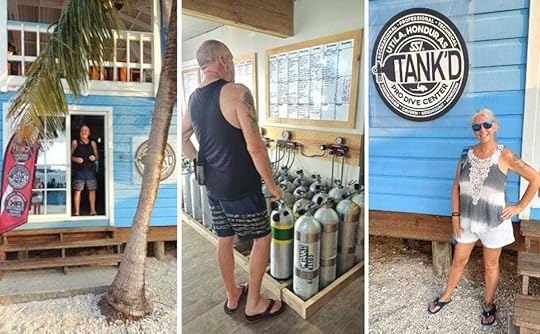 Tank’d Pro Dive Centre on Utila Honduras
Tank’d Pro Dive Centre on Utila Honduras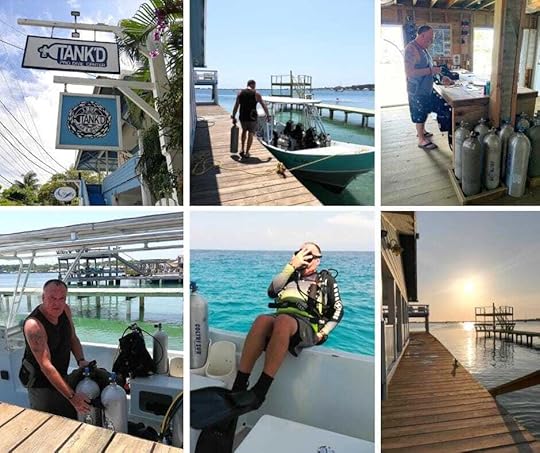 The backpacking husband at Tank’d Pro Dive Centre
The backpacking husband at Tank’d Pro Dive CentreOn Koh Tao, the backpacking husband went on to further his Dive Professional Qualifications, leading up to his PADI IDC Staff Instructor and would highly recommend (link to their website) Ban’s Dive Centre on Sairee Beach Koh Tao.
The KLOOK advertisement below contains an affiliate link
Klook.com (function (d, sc, u) { var s = d.createElement(sc), p = d.getElementsByTagName(sc)[0]; s.type = "text/javascript"; s.async = true; s.src = u; p.parentNode.insertBefore(s, p); })( document, "script", "https://affiliate.klook.com/widget/fe..." );Ban’s has a reputation for quality diver training and is rated as a PADI 5 Star Career & Instructor Development Centre and is affectionately known as the ‘home of diving’ in Thailand.
Ban’s Diving Resort on Sairee Beach also has fabulous resort amenities with a choice of accommodations and swimming pools and a restaurant and beach bar.
I made a few short videos during my last trip to Koh Tao while staying at Ban’s to give you a flavour of the resort.
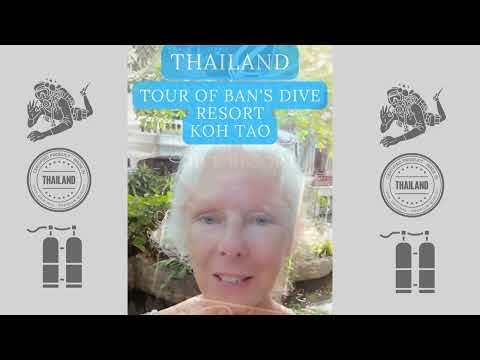
A short tour of Ban’s Dive Resort Koh Tao Thailand
If a smaller beach resort on Koh Tao with less crowds and smaller groups is your preference I’d also personally recommend (link to their website) Assava Dive Centre to you.
Assava Dive Centre is located on the beachfront at Chalok Bay on Koh Tao.
It is also a PADI 5 Star Dive Centre and is affiliated with Ban’s Diving Resort.
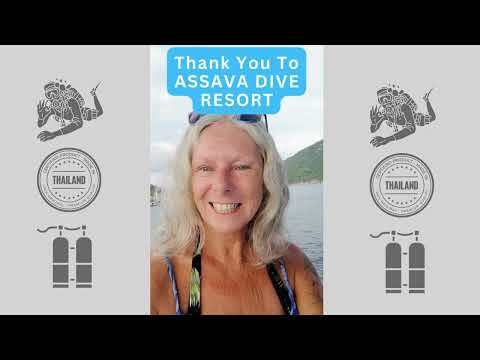
Diving Training with Assava Dive Resort Koh Tao Thailand
Either way you’ll be diving with the best and at the very best prices.
Ban’s on Koh Tao and Tank’d on Utila are my personally recommended dive centres, but I also suggest you do your own research, as both islands have lots of good dive centres and many offer accommodation and dive course combinations.
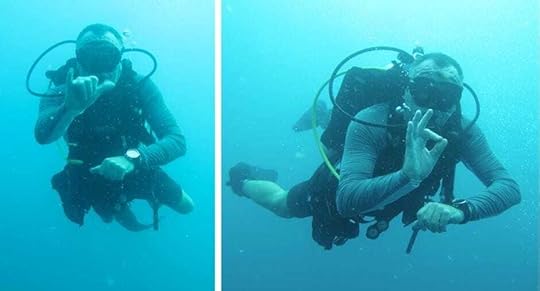 The backpacking husband is a PADI IDC Staff InstructorKOH TAO VS UTILA SIMILARITIES
The backpacking husband is a PADI IDC Staff InstructorKOH TAO VS UTILA SIMILARITIESKoh Tao is the smallest of three islands in the Gulf of Thailand. The other two islands are called Koh Samui and Koh Phangan.
Utila is the smallest of three Bay Islands in the Caribbean Sea, just off the coast of Honduras, in Central America. The other two islands are called Roatan and Guanaja.
Both Koh Tao and Utila are similar in size in landmass. Utila is geographically larger (45 sq/km) than Koh Tao (21 sq/km) but half of Utila’s interior is mangrove and lagoon so taking that into account makes them similar in size.
Both islands are renowned for their excellent diving and snorkelling opportunities making them known as ‘Mecca’ for diving enthusiasts from all around the world.
Because of the rich marine biodiversity, coral reefs, and clear waters, both Koh Tao and Utila are both popular spots for people looking to learn to dive and to gain more advanced scuba diving certifications.
 Wreck Diving is a PADI Qualification
Wreck Diving is a PADI QualificationBoth islands offer numerous dive schools and are known for affordable courses.
Both islands rely heavily on tourism, so you’ll find lots of accommodation options, restaurants, bars, and tour operators.
Both islands have relatively small resident populations, contributing to a wonderful tight-knit community feel that you can appreciate as a tourist. This ‘feel’ makes you want to stay a lot longer than you might have planned to stay.
I’ve certainly found this to be true.
Both islands are known for their laid-back, relaxed atmospheres. Although, until recently, they were known as backpacker and budget traveller destinations, both islands now also offer more medium and high-end accommodations, restaurants, bars, and travel experiences.
Despite their small sizes, both islands have nightlife scenes that mostly focus around dive centres, beach bars, and beachside restaurants.
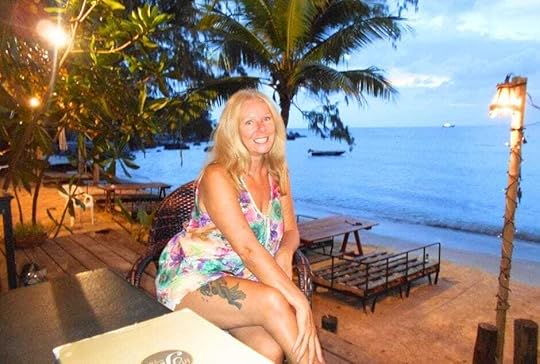 I do enjoy beach bars – Koh Tao Thailand
I do enjoy beach bars – Koh Tao ThailandOn Utila, many bars and restaurants and cafes are on stilted wooden docks to take advantage of warm sea breezes while also avoiding biting flies.
Both Koh Tao and Utila boast beautiful natural surroundings, including sandy beaches, lush tropical vegetation, and picturesque landscapes.
Both islands encourage visitors to take part in efforts to preserve their natural environments and marine ecosystems. There are organised beach clean ups and opportunities to take part on endangered turtle conservation.
Koh Tao means ‘turtle island’.
KOH TAO VS UTILA WHALESHARKSWhale sharks are a major attraction for marine tourism in various parts of the world and Koh Tao in Thailand and Utila in Honduras are known as two of the top places in the world for whale shark sightings.
 Koh Tao and Utila are two of the top places in the world for whale shark sightings.
WHALE SHARK – THE GENTLE GIANT
Koh Tao and Utila are two of the top places in the world for whale shark sightings.
WHALE SHARK – THE GENTLE GIANT
The whale shark (Rhincodon typus) is not actually a shark but a fish. It’s the largest fish species in the world.
Whale sharks can grow up to 12 meters (about 39 feet) in length on average, although some individuals have been reported to reach lengths of up to 18 meters (about 59 feet).
Despite its massive size, the whale shark is known for its gentle nature and is often referred to as a gentle giant.
Whale sharks are known to be docile and approachable, often allowing divers and snorkelers to swim alongside them.
They have a broad flat head with a large mouth and feed by swimming slowly with their mouths open to filter food through their gill rakers, primarily consuming plankton, small fish, and other tiny marine organisms.
Whale sharks have distinctive patterns of light spots and stripes on a dark grey or blue-grey background, which are unique to each individual and can be used for identification.
Whale sharks are found in tropical and warm temperate oceans worldwide.
They are often spotted in coastal areas, around coral reefs, and in the open sea.
The whale shark is listed as an endangered species due to threats such as overfishing, bycatch in fishing gear, and habitat destruction.
 KOH TAO WHALE SHARKS
KOH TAO WHALE SHARKS
Whale sharks are often spotted around Koh Tao primarily from February to May and into June when conditions are favourable for plankton blooms that attract whale sharks.
The rich biodiversity and healthy coral reefs around Koh Tao provide an abundant food source for whale sharks making an attractive feeding ground.
The island has many dive sites where whale shark sightings are reported regularly, such as Chumphon Pinnacle and Southwest Pinnacle which are accessible to divers of all skill levels.
UTILA WHALE SHARKSUtila is known for having year-round whale shark sightings, though the peak seasons are typically from March to April and August to September.
Utila’s position along the Mesoamerican Barrier Reef System, the second-largest barrier reef in the world, provides a nutrient-rich environment that supports large populations of plankton, attracting whale sharks.
Utila has a strong focus on whale shark research and conservation. The Whale Shark & Oceanic Research Centre (WSORC) on the island conducts research and promotes sustainable tourism practices, enhancing the likelihood of sightings.
WHERE IS KOH TAO AND HOW TO GET THEREKoh Tao is one of the main islands in an archipelago located in the Gulf of Thailand and is part of the Surat Thani Province.
The island is accessible by ferry from the mainland ports of Chumphon and Surat Thani, as well as from neighbouring islands.
Koh Tao does not have an airport.
The closest international airports are at Koh Samui and Surat Thani.
Perhaps the most common route to and from Koh Tao is via ferry from Koh Samui (distance 70 km or 43 miles) or from Koh Phangan (45 km or 28 miles).
My own route to and from Koh Tao is more often via ferry to/from mainland Surat Thani and then by bus from/to the airport.
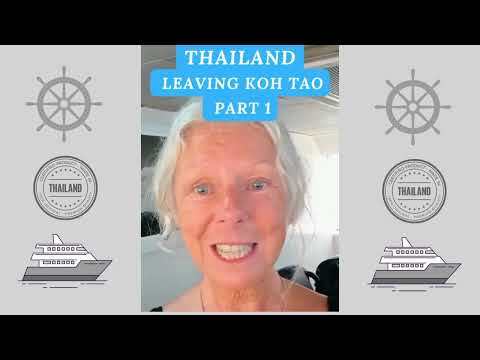
WHERE IS UTILA AND HOW TO GET THERE
Utila is one of the Bay Islands (Islas de la Bahía) located in the Caribbean Sea off the northern coast of Honduras.
Roatán, the largest and most developed of the Bay Islands, is located about 32 km (20 miles) east of Utila.
The island can be reached by ferry from Roatan and from the mainland city of La Ceiba or by small plane.
Utila has a small airport but it’s more of a air strip really as it has no lights so only operates by day.
My usual route to Utila is via a flight from Miami or Houston USA to either Roatan or to San Pedro Sula (Honduran mainland).
Then it’s either the Utila Dream Ferry from Roatan or a small plane from San Pedro Sula.
 Utila has a small airport but it’s more of a air strip really
WHEN IS THE BEST TIME TO DIVE KOH TAO
Utila has a small airport but it’s more of a air strip really
WHEN IS THE BEST TIME TO DIVE KOH TAO
The best time to visit Koh Tao, Thailand, is generally during the dry season.
December to April: is the dry season with plenty of sunshine and minimal rain, making it ideal for beach activities, diving, and snorkelling.
December to February: is the peak tourist season, especially around Christmas and New Year. Expect more crowds and higher prices for accommodation and activities. I’ve personally spend two Christmases and New Years on Koh Tao and it has been a time of wonderful fun, fabulous weather, and great diving days.
March to May: The crowds start to thin out, making it a good time to visit if you prefer a balance of good weather and fewer tourists.
April to September: This period often provides the best diving conditions with good visibility and calm seas. However, conditions can vary, and it’s best to check local forecasts and dive shop reports.
Songkran (Thai New Year) is celebrated in mid-April. Songkran is a fun and lively festival with water fights and celebrations. It’s a fabulous cultural experience but note that this time of the year also attracts more tourists.
May to September: The weather is still relatively good, but there’s a higher chance of rain, particularly in the late afternoons. It can be a bit humid but still a decent time to visit.
October to November: This is the monsoon season with the heaviest rainfall, making it the least favourable time to visit. However, it doesn’t always rain all day or every day, so some prefer this time for lower prices and fewer tourists.
For more guidance see my post on The Best and Worst Times to Visit Thailand.
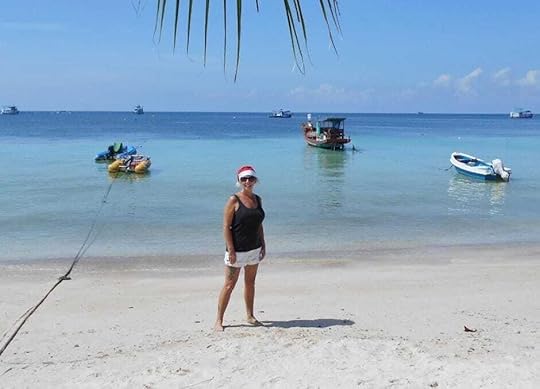 Christmas Day on Koh Tao Thailand
WHEN IS THE BEST TIME TO DIVE UTILA
Christmas Day on Koh Tao Thailand
WHEN IS THE BEST TIME TO DIVE UTILA
The best time to travel to Utila, Honduras, is typically during the dry season, but I’ve often been on the island from February when there are still quite a few rainy days and into October when the rainy season is about to start.
February to June (Dry Season): In my opinion the months of March, April, and May, are the most pleasant on the island because it is dry and hot and humid but you do have the benefit of the east winds to cool you down.
The dry season is the peak tourist season so expect higher prices and larger crowds. Many Hondurans from the mainland like to go to Utila during this time for their holidays/vacations. Especially over Samana Santa (the week before Easter). It’s advisable to book accommodations and diving courses in advance.
Diving: The dry season is perfect for diving, with excellent underwater visibility and calm sea conditions. It is also the best time to see whale sharks, as they are often spotted around Utila from March to April.
July to November (Wet Season): These months experience higher humidity and more frequent rainfall with the possibility of tropical storms and hurricanes, particularly from September to November.
Utila Carnival is held in July and I absolutely love carnival time.
 Utila Carnival is great fun and is held in July
Utila Carnival is great fun and is held in JulyAgain, in my opinion, if you suffer in high heat and humidity then you should perhaps avoid July and August on Utila as the east wind usually drops leaving flat calm seas (often an excellent time for seeing whale sharks) and the heat is really is oppressive and the mosquitoes and no-see-ums (sandflies) are at their very worst.
See my post and expert guide on how to stop biting flies spoiling your tropical holiday!
Diving: While diving is still possible, visibility may be reduced, and conditions can be less predictable. However, the island is less crowded, and prices for accommodations and activities might be lower.
December to January: This period marks a transition from the wet to the dry season. The weather can be mixed, with occasional rain, but it is generally improving.
Diving: Diving conditions begin to improve and the island starts to see an increase in visitors. Whale sharks may start to appear towards the end of January.
KOH TAO VS UTILA – MY OPINIONSIt is my opinion that Koh Tao and Utila – despite their many similarities – are very different from each other geographically, historically, and culturally, so offer very different visitor and diving experiences.
Perhaps for a non-diver, there are more similarities in Koh Tao and Utila, in the respect that both offer a choice of tropical white sand beaches lined with palm trees and fun bars to hang out for drinks and great places to eat.
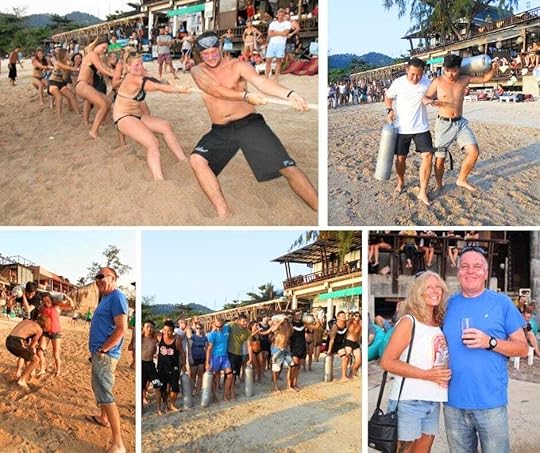 Ban’s Dive Resort Team Games which the backpacking husband helped to organise
Ban’s Dive Resort Team Games which the backpacking husband helped to organise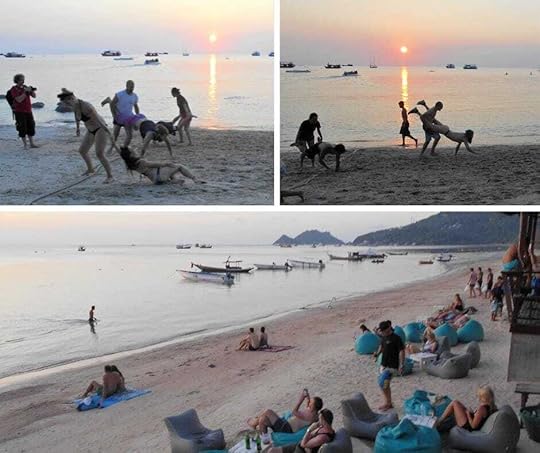 The Ban’s Dive Resort Games were great fun and went on all day on Sairee Beach Koh Tao
KOH TAO VS UTILA – MY CONCLUSIONS
The Ban’s Dive Resort Games were great fun and went on all day on Sairee Beach Koh Tao
KOH TAO VS UTILA – MY CONCLUSIONS
Having spent many months (which all added up to a few years!) on each of these very special islands, I can absolutely recommend both Koh Tao and Utila to you for travels, your holiday/vacations, and as fabulous and fun dive destinations.
But in this post, as we are comparing Koh Tao and Utila primarily as Dive Destinations, below are my conclusions.
UTILA
I’d say that Utila has the upper hand over Koh Tao as a dive destination simply because of its geographical location on the Mesoamerican Reef – the second largest barrier reef in the world.
Utila therefore – in my opinion – offers the best scuba diving experience and best location for advanced diver training.
The waters surrounding the Bay Islands are warm, crystal clear and offering fantastic visibility, and the reef is teeming with a variety of marine life.
It’s not unusual to dive and to swim (and I have done so) with huge barracuda, dolphins, turtles, pilot whales, and whale sharks, in Utila’s tropical waters.
Number of Dive sites: there are around 90 dive sites surrounding Utila.
Number of Dive Centres: there are reportedly 12 PADI/SSI dive centres on Utila.
 The backpacking husband working on a dive project off Utila Honduras
The backpacking husband working on a dive project off Utila Honduras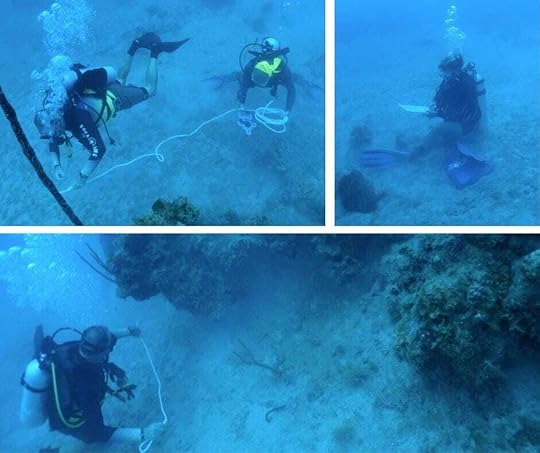 Divers working on an underwater archaeological project
Divers working on an underwater archaeological project I believe Utila is also the best place to go onto do advanced dive training and professional training and also specialised dive training like Extended Range. Classes tend to be smaller and advanced diving more specialised.
Especially, as Tank’d Pro Dive Centre on Utila is recognized in excellence and leadership in SSI Extended Range diving and XR Instructor Training.
KOH TAOIt’s my opinion that Koh Tao is perhaps the best place for you to go to learn to dive because the professional staff and training facilities at Ban’s Diving Resort and Assava Dive Resort really are world class.
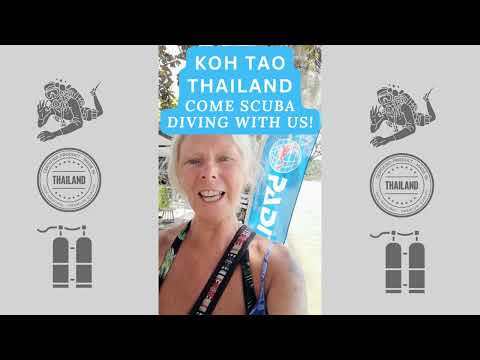
Ban’s Diving Resort and Assava Dive Resort on Koh Tao are world class dive centres
Ban’s Resort is huge and is famously the world’s most certifying PADI 5 Star scuba training facility celebrating 250,000 divers and prices in Asia are comparatively lower – and slightly lower than Utila – at the time I checked.
All the dive sites around Koh Tao are all a boat ride away and groups tend to be larger but Ban’s has lots of big fully equipped dive boats and expert staff.
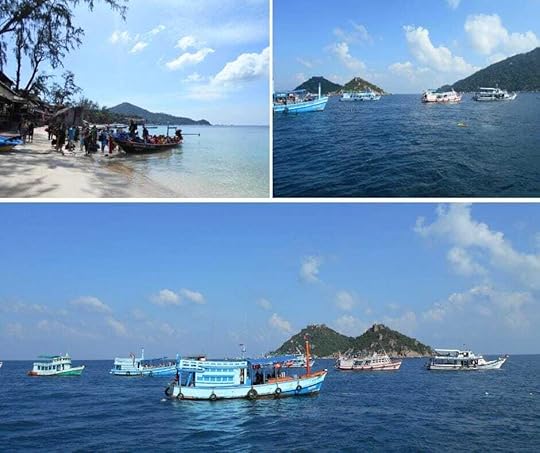 Dive Boats on a dive site off Koh Tao Thailand
Dive Boats on a dive site off Koh Tao ThailandNumber of Dive sites: there are around 30 dive sites off Koh Tao.
Number of Dive Centres: there are reportedly 85 PADI/SSI dive centres on Koh Tao.
It is my experience that the water clarity and visibility is not always good off Koh Tao and there are not as many species of tropical fish and marine life or corals to see compared to Utila.
MY CONCLUSION is that Utila offers the best scuba diving experience and best location for advanced diver training.
MY CONCLUSION is that Koh Tao wins as the best place to learn to scuba dive.
Do you scuba dive?
Is learning to scuba dive on your bucket list?
Have you been to Koh Tao?
Have you been to Utila?
Do you have an opinion on Koh Tao vs Utila?
Let me know in the comments.
I’d love to hear from you!
 Klook.com (function (d, sc, u) { var s = d.createElement(sc), p = d.getElementsByTagName(sc)[0]; s.type = "text/javascript"; s.async = true; s.src = u; p.parentNode.insertBefore(s, p); })( document, "script", "https://affiliate.klook.com/widget/fe..." );
Klook.com (function (d, sc, u) { var s = d.createElement(sc), p = d.getElementsByTagName(sc)[0]; s.type = "text/javascript"; s.async = true; s.src = u; p.parentNode.insertBefore(s, p); })( document, "script", "https://affiliate.klook.com/widget/fe..." );THE BACKPACKING HOUSEWIFE RECOMMENDS TRAVEL INSURANCE
GET A NO OBLIGATION QUOTE FROM WORLD NOMADS TODAY
The post Dive Islands: Koh Tao vs Utila appeared first on The Backpacking Housewife.
June 25, 2024
Thailand: Chiang Mai to Bangkok by Train
Having explored Chiang Mai’s temples and shrines and enjoyed the fortified city’s cafes and amazing food for several days, I suggested travelling on from Chiang Mai to Bangkok by Train.
But, my best friend and travelling companion with whom I was travelling in Thailand, wasn’t totally convinced. She explained that taking the flight would be much faster, taking just over an hour, for us to land in Bangkok.
But somehow, I managed to persuade her that having already flown from Koh Samui to Chiang Mai, that taking the classic train journey – one of the longest in Thailand – would be a fabulous and authentic culturally immersive experience for us both.
Especially if we opted to take the day train.
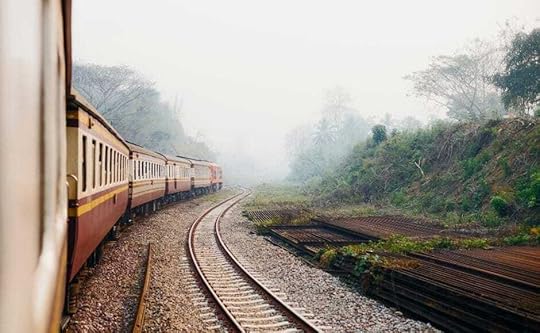 There are many benefits to travelling from Chiang Mai to Bangkok by TrainWHAT IS THE BEST WAY TO GET FROM CHIANG MAI TO BANGKOK?
There are many benefits to travelling from Chiang Mai to Bangkok by TrainWHAT IS THE BEST WAY TO GET FROM CHIANG MAI TO BANGKOK?I understand it suits some people to take the night train to Bangkok as it offers overnight services with sleeper berths.
But, I argued, that if we took the day train we could gaze out of the window and see lots of the scenic countryside.
We’d also gain first-hand insights into Thailand’s development and heritage as we tracked slowly for the four-hundred and thirty-six miles (580km) to the capital city.
It’s true that the train journey from Chiang Mai to Bangkok travels through some of Thailand’s most beautiful landscapes, including lush forests, mountains, and rural countryside, offering views that are missed when flying.
Plus, trains provide more space to move around compared to airplanes or buses.
I explained to my friend that she could stretch her legs and enjoy a more relaxed travel experience without the hassle of airport security and delays.
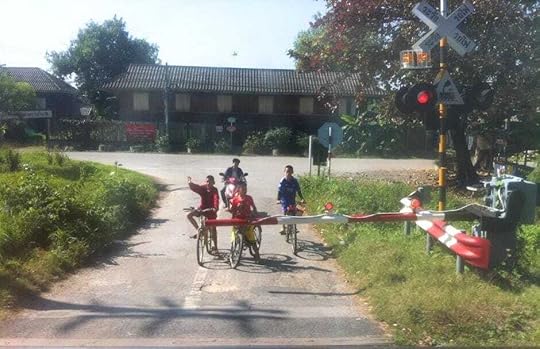 Thailand’s countryside and small towns. Photo by Janice Horton
Thailand’s countryside and small towns. Photo by Janice HortonThen there is of course also the important issue of our traveller’s carbon footprint.
Train travel is more environmentally friendly compared to air travel as it produced less carbon dioxide per passenger kilometre.
It’s also worth considering the travel budget. Because taking the train is more cost effective and budget-friendly option as train tickets are generally cheaper than flight tickets. I worked out that the money we saved on taking the train rather than the plane might pay for our one night’s accommodation in Bangkok.
And, in arriving in the city centre station rather than at the airport location, we’d have easier and quicker access to our centrally located hotel.
Well, if I hadn’t yet convinced my dear friend, I’d certainly convinced myself that taking the train would be a much better and culturally romantic idea.
I imagined it would be a journey we could talk about together in years to come with nostalgia and great affection.
I also imagined that the train would have a dining car where we could enjoy a variety of Thai dishes at our leisure to add to the charm of the journey.
There are five trains from Chiang Mai to Bangkok per day and the daytime train Number 8 departing at 08.50am is said to be the most popular as it is scheduled to be the fastest service.
And so, it was agreed, that we’d travel from Chiang Mai to Bangkok by Train!
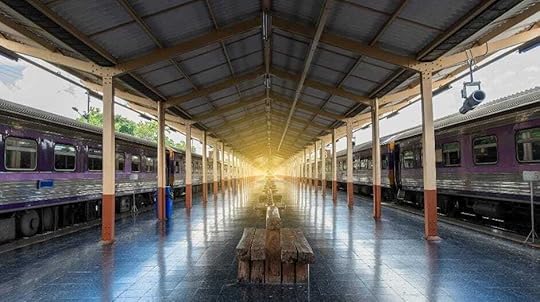 A romanticised version of travel from Chiang Mai to Bangkok by Train
A romanticised version of travel from Chiang Mai to Bangkok by TrainWe arrived at historic Chiang Mai Train Station – known as Sathani Rot Fai Chiang Mai in Thai – early in the morning in a taxi.
Located about 3 kilometres from the centre of Chiang Mai, the station is easily accessible by taxi, tuk-tuk, or public transportation. The original train station dating back to 1922 was destroyed by air strikes in 1943 and so the station which stands today was rebuilt in 1945 but still holds an old charm.
 Chiang Mai Train Station. Photo by Janice Horton
Chiang Mai Train Station. Photo by Janice HortonIn anticipation of the long journey ahead – as I was now starting to doubt the existence of a dining car – we first popped across the road into the 7-11 Store opposite the station to stock up on snacks and drinks.
Then, with a carrier bag each full of sustenance, we headed into the station.
I admired the old steam locomotive on display and marvelled at the somewhat nostalgic Thai and colonial architectural style.
 On the platform with the Number 8 ‘Special Express’ train to Bangkok HOW LONG IS THE TRAIN RIDE FROM CHIANG MAI TO BANGKOK?
On the platform with the Number 8 ‘Special Express’ train to Bangkok HOW LONG IS THE TRAIN RIDE FROM CHIANG MAI TO BANGKOK?As we had already bought our 2nd Class tickets in advance and online from (affiliate link) KLOOK we bypassed the information desks and ticket counters and headed past Buddha deities and elephant statues to the platform where the Number 8 ‘Special Express’ train was scheduled to leave at 08.50am to arrive in Bangkok at 18.55pm.
Making the train ride from Chiang Mai around ten hours long (as a guide) as it can sometimes take longer.
You can buy your train ticket on the day but be prepared to wait in a long line at the station.
Also be warned that the trains are busy – especially the most popular train Number 8 – and so tickets are often sold out on the day of travel. You can find out more about ticket prices and schedules at the Thailand Trains Website.
 Taking the Number 8 ‘Special Express’ train to Bangkok
Taking the Number 8 ‘Special Express’ train to Bangkok Our tickets were checked as we boarded the carriage, and as we were the first to arrive, we had our choice of seats.
We opted for mid-carriage to benefit from some distance from the toilet and as many ceiling fans as possible.
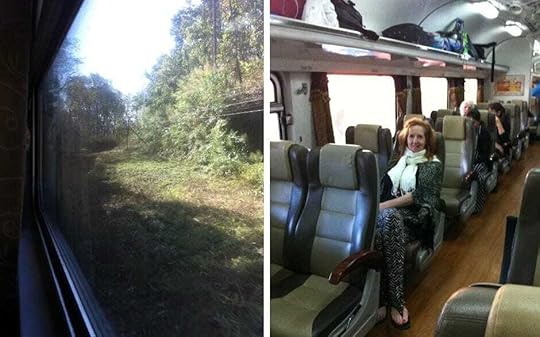 We opted to sit mid-carriage from Chiang Mai to Bangkok by Train
We opted to sit mid-carriage from Chiang Mai to Bangkok by TrainThe second class carriage promised air-conditioning once we were underway but it was stiflingly hot inside.
I immediately noted the classic décor and old two-tone brown and black vinyl covered seats and sincerely hoped that my friend hadn’t seen the sudden doubts etched on my face at the thought of the perhaps gruelling journey ahead of us.
The carriage soon filled up with men, women, children and everyone had a 7-11 store carrier bag full of snacks and drinks.
Then we were off and my sense of optimism returned as we smoothly rode through the Thai countryside and small towns and villages and then out into the plains where there was actually nothing but rice field after rice field after rice field.

 Thailand’s beautiful landscapes and rural countryside. Photo by Janice Horton
Thailand’s beautiful landscapes and rural countryside. Photo by Janice HortonLunch was included in the ticket price and it came to us on a trolly pushed along by a very grumpy Thai lady, who actually flung the plastic cartons of food either onto your plastic tray or straight into your lap, while she hissed something indecipherable in Thai. We were more entertained than offended.
Some people opened and sniffed at their lunches and some didn’t bother.
But nobody I saw actually ate any of it.
We were curious so peeled back the plastic lid to smell curry and see something that resembled a fish’s head in a gooey broth.
Oh well, thankfully we had our 7-11 supplies and happily tucked into sandwiches and hard boiled eggs and crisps, instead.
 Lunch was included in the ticket price
Lunch was included in the ticket price Despite the gruelling length of the journey and the basic conditions on board, we had a lot of laughs on that train journey, as we sat in our sticky and sweaty seats and entertained ourselves by playing silly games with our empty crisp packets.
 Playing silly games with our empty crisp packets
Playing silly games with our empty crisp packetsAfter ten hours the carriage windows had steamed up and it was hard to see any rice fields or our much anticipated arrival into Hua Lamphong Station in Bangkok.
And the floor was littered with snacking debris and spilled fish heads.
The air was filled with the sounds of incessant snoring and the awful smell of putrid wafts from the toilet.
 Scarfs over our noses against the awful wafts from the toilet
Scarfs over our noses against the awful wafts from the toiletWeary with travel fatigue and hoping for an imminent arrival, we wrapped our scarfs over our noses and through misted up windows, and hoped for a blurry silhouette of Bangkok to appear like a miracle on a blazing red and orange horizon.
Perhaps it was a mirage rather than a miracle and one that kept us hoping and guessing from a distance.
 Bangkok appeared like a miracle on a blazing red and orange horizon
Bangkok appeared like a miracle on a blazing red and orange horizonIt actually took twelve hours of travel for us to arrive in Bangkok.
Which was two hours longer than expected.
But my dear friend and I still talk about taking that legendary journey from Chiang Mai to Bangkok by train.
It felt like an adventure. We’re sure we’ll be retelling the story of those twelve hours well into our old age.
It was certainly all we’d hoped for regarding an authentic and culturally immersive experience.
And one we wouldn’t have had if we’d simply taken the plane.
We laughed about it then and we laugh about it now, and happily reminisce about that special time we had together, travelling across Thailand from Chiang Mai to Bangkok by train.
 The legendary journey from Chiang Mai to Bangkok by train
The legendary journey from Chiang Mai to Bangkok by trainHave you ever taken an adventurous or epic train journey?
Have you travelled in Thailand or in South East Asia by train?
Have you been to Chiang Mai?
Let me know – leave a comment below – I’d love to hear from you!
 Klook.com (function (d, sc, u) { var s = d.createElement(sc), p = d.getElementsByTagName(sc)[0]; s.type = "text/javascript"; s.async = true; s.src = u; p.parentNode.insertBefore(s, p); })( document, "script", "https://affiliate.klook.com/widget/fe..." );
Klook.com (function (d, sc, u) { var s = d.createElement(sc), p = d.getElementsByTagName(sc)[0]; s.type = "text/javascript"; s.async = true; s.src = u; p.parentNode.insertBefore(s, p); })( document, "script", "https://affiliate.klook.com/widget/fe..." );The post Thailand: Chiang Mai to Bangkok by Train appeared first on The Backpacking Housewife.
May 23, 2024
Thailand: Chiang Mai – My Top Temples Tour
What makes Chiang Mai so special to both the visitor’s eye and to the pilgrim’s spirit are its ancient religious and time worn architectural sites and its location in the sacred mountainous region of Northern Thailand.
And, although today’s Chiang Mai is Thailand’s second largest city, it still manages to retain its identity of age-old importance.
In every nook you may wander and in every place you might look, you’ll see the evidence and patina of a bygone age and the remnants of a fascinating history.
In visiting Chiang Mai, I was looking forward to exploring the former capital of The Lanna Kingdom (founded in 1296) and I was particularly excited to visit as many of Chiang Mai’s Buddhist temples as possible.
Chiang Mai is home to over 300 sacred Buddhist temples.
So how do you know what temples should you visit in Chiang Mai during your visit?
In this post, I want to share with you my own personal Top Temples Tour in Chiang Mai!
 The temples in Chiang Mai contribute to the city’s standing as an important centre of Thai Buddhism
The temples in Chiang Mai contribute to the city’s standing as an important centre of Thai BuddhismTABLE OF CONTENTS
CHIANG MAI ITINERARYMY TRIP TO CHIANG MAICHAING MAI – MY TOP TEMPLES TOURWAT PHRA THAT DOI SUTHEPTHE LEGEND OF THE WHITE ELEPHANTWAT CHEDI LUANGWAT PHRA SINGWAT CHIANG MANWAT SUAN DOKWAT LOK MOLIWAT SRI SUPHAN (SILVER TEMPLE)THE ALMS-GIVING RITUAL (TAK BAT)TEMPLE ETIQUETTE IN THAILANDBEST TIME TO VISIT CHAING MAI? CHIANG MAI ITINERARYChiang Mai is a cultural and spiritual city.
In exploring some of its 300 Buddhist temples while in the company of my lifelong best friend, for many reasons, I would rate my experiences in Chiang Mai as both incredibly special and spiritually profound.
So much so, that Chiang Mai played a starring role as a setting in my bestselling novel The Backpacking Housewife (book one) published by HarperCollins.
To my delight, I had readers writing to tell me they’d used my heroine Lori’s journey to Chiang Mai as part of their own itinerary while visiting Thailand!
You can read more about my novels on My Books Page.
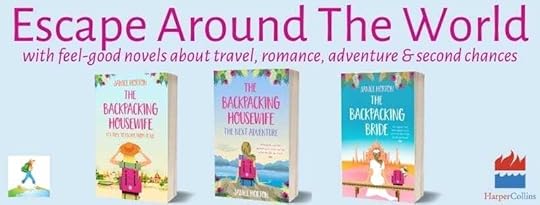 MY TRIP TO CHIANG MAI
MY TRIP TO CHIANG MAI
I travelled to Chiang Mai with my best friend D who had come over to Thailand from the UK on holiday.
First, we’d spent a week together on an island in the Gulf of Thailand called Koh Tao.
Then, while the backpacking husband was busy doing scuba diving stuff, we took an inter-island ferry over to Koh Samui and the one hour and twenty-minute flight direct to Chiang Mai.
 Best friends on a Thai Temple Tour to Chiang Mai!
Best friends on a Thai Temple Tour to Chiang Mai!
In Chiang Mai, we planned to explore the walled and moated old city, enjoy the coffee shop culture and try delicious northern Thai food, and – of course – to visit as many Buddhist temples as possible during our five days there.
We stayed at a wonderful hotel in a great location and with great reviews called (affiliate link) Villa Korbhun Khinbua.
I booked our accomodation in Chiang Mai using (affiliate link) Booking Dotcom.
We got around the walled city by walking or taking a taxi tuk tuk!
 Getting around the walled city by taxi tuk tuk!
Getting around the walled city by taxi tuk tuk!The temples I’ve listed as My Top Temples Tour in Chiang Mai are among the most important and the most visited in Chiang Mai as each offers a glimpse into the region’s rich religious and cultural heritage.
While my list below covers some of the most significant temples, Chiang Mai’s numerous other temples have their own unique charm and history.
Each of the temples in Chiang Mai contributes magnificently to the city’s standing as an important centre of Thai Buddhism and Lanna culture.
CHAING MAI – MY TOP TEMPLES TOUR WAT PHRA THAT DOI SUTHEPThis is the most famous temple in Chiang Mai with a rich history dating back to the 14th century, when in 1383, it was founded by the Lanna king, Keu Naon.
Wat Phra That Doi Suthep is named after and is located on Doi Suthep Mountain.
From its elevated position, overlooking the city there are panoramic views over Chiang Mai.
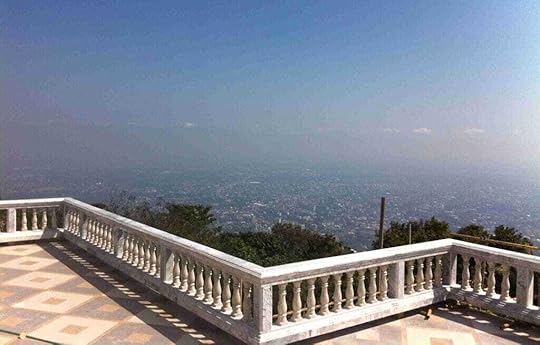
This temple is an important pilgrimage destination for Buddhists and international visitors.
It’s also a focal point for some of Chiang Mai’s important Buddhist holidays when devotees make the trek up Doi Suthep to participate in religious ceremonies.
We took an open back truck public taxi called a songthaew from Chiang Mai up the winding mountain roads to the temple.
To enter the temple, after paying your 50B entrance fee, you can either take the funicular cable car or walk up the 300 steps of the Naga Serpent Staircase.
I found the temple to be a serenely spiritual place and I enjoyed walking the Pradakshina around the site, in total awe of the breathtakingly stunning golden chedi (also known as a pagoda or stupa) and all the shining gold-plated Buddha statues, and those in contemplation and prayer and lighting candles.
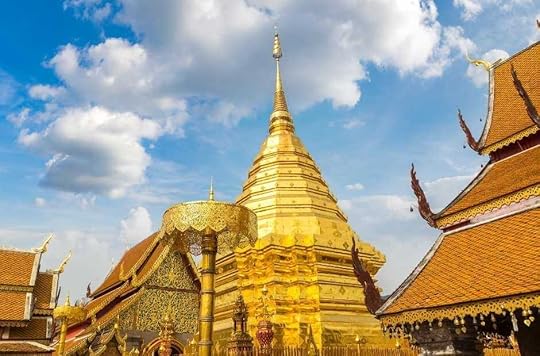
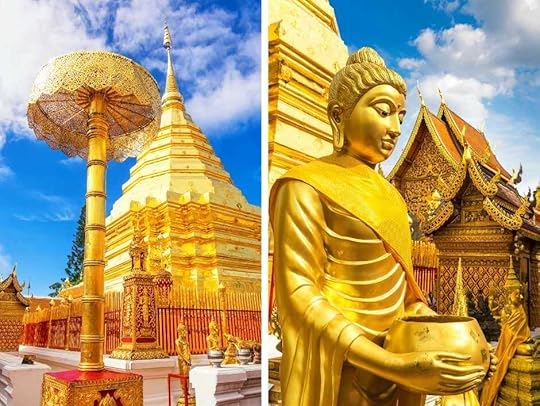
 The breathtakingly stunning golden Buddha images and Chedi at Wat Phra That Doi Suthep
The breathtakingly stunning golden Buddha images and Chedi at Wat Phra That Doi SuthepI browsed amongst the bells and gongs and rang them because the bells are said to represent Buddha’s voice and in ringing them you can ask for his guidance and protection.
 I browsed amongst the bells and gongs
I browsed amongst the bells and gongs It was fascinating to stroll into the smaller temples where saffron swathed monks prayed and chanted.
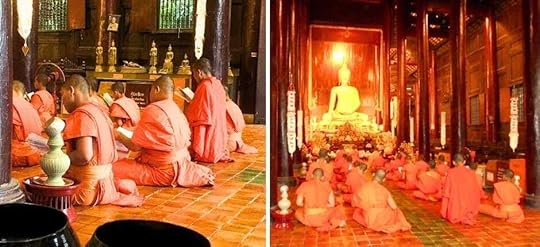
 It was fascinating to sit quietly where saffron swathed monks prayed and chanted
It was fascinating to sit quietly where saffron swathed monks prayed and chantedOne of the most captivating stories I heard was about the founding of Wat Phra That Doi Suthep.
It is a blend of legend and history and about the elephant that played a pivotal role in discovering the original sacred site.
 The Legend of The White Elephant
THE LEGEND OF THE WHITE ELEPHANT
The Legend of The White Elephant
THE LEGEND OF THE WHITE ELEPHANT
In the 14th century, the King of the Lanna Kingdom (which encompassed present-day northern Thailand) called Nu Naone, had a vision to enshrine a sacred relic of the Buddha.
This relic was a shoulder bone, believed to possess miraculous powers, including the ability to glow and replicate itself.
A monk named Sumanathera, who had travelled to Sukhothai, was entrusted with the relic.
He presented it to King Nu Naone, who decided to find a worthy place to enshrine it.
To determine the location, the king placed the relic on the back of a sacred white elephant, a revered animal in Thai culture symbolizing purity and power.
The elephant was then set free to roam, with the belief that it would choose an auspicious location for the relic.
The white elephant wandered through the jungles and hills of northern Thailand.
After a long journey, it ascended Doi Suthep, a mountain overlooking Chiang Mai.
Upon reaching a spot on the mountain, the elephant trumpeted three times, knelt down, and died on the spot.
This was interpreted as a divine sign, indicating that the site was chosen by the gods for the relic.
Following this event, King Nu Naone ordered the construction of a temple at the site where the elephant died.
This temple was named Wat Phra That Doi Suthep.
The relic was enshrined in a golden chedi within the temple, which remains a major pilgrimage site to this day.
HOW TO GET TO WAT PHRA THAT DOI SUTHEP
Take a songthaew from Chaing Mai transport stand at the North Gate.
Address: Doi Suthep Mountain, Mueang Chiang Mai District, Chiang Mai 50200, Thailand
WAT CHEDI LUANGThis enormous 15th century temple (dating back to 1481) was ordered to be constructed by King Saen Muang Ma to enshrine the ashes of his father.
It is both famous and known for its huge and impressive old stone chedi that once stood over 80 meters tall and its once intricate carved stone Nagas (mythical serpents) flanking the steep worn stone staircases on each side of the massive structure.
On a large platform before the top of the Chedi are carved stone Sinhalese-style stone elephants.
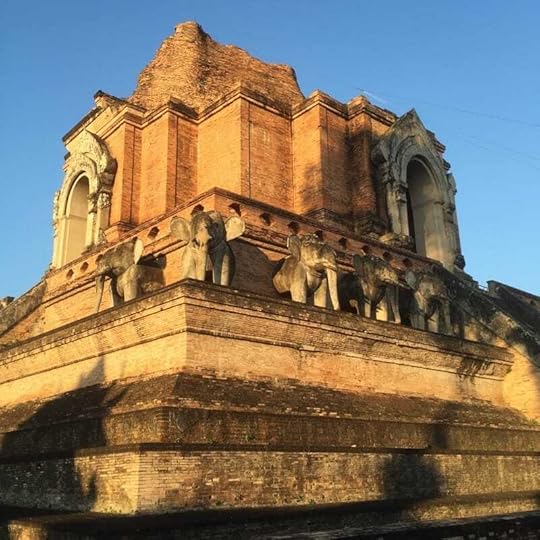

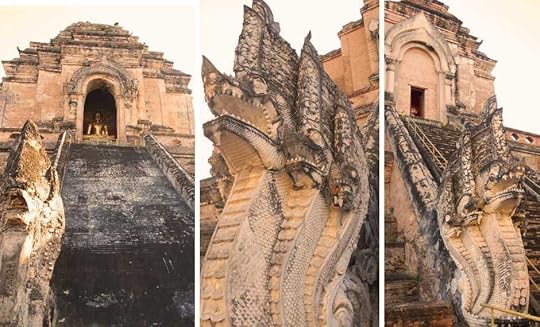
The famed Phra Kaew (Emerald Buddha) which is now housed in Bangkok’s Wat Phra Kaew Temple was once held here (until 1475) in the eastern corner of the temple complex where today you can see a jade replica.
I found myself quite mesmerised by this incredible structure and its rich historical and religious significance here in Chiang Mai.
Also at the complex is the Reclining Buddha Pavilion.
Constructed in 1955, the pavilion, is home to an almost nine meter long and five centuries old ‘Reclining Buddha’ crafted during the reign of King Muang Kaeo, who ruled the Lanna Kingdom from 1487 to 1517.
 Reclining Buddha
Reclining BuddhaI have visited a Reclining Buddha in other parts of the world, most recently in Fukuoka Japan, and although you might think the pose is one Buddha blissfully relaxing, it is actually a rendition of Buddha’s final moments on earth.
The Reclining Buddha is always portrayed with a look of peace on his face as he prepares to enter nirvana.
HOW TO GET TO WAT CHEDI LUANG
Wat Chedi Luang is also known as the City Pillar Shrine and as such is located in the centre of the walled city.
Address: 103 Prapokkloa Rd, Mueang Chiang Mai District, Chiang Mai 50200, Thailand
WAT PHRA SINGThe Temple of The Lion Buddha, Wat Phra Sing, is one of the most popular and highly visited temples in the western part of the Old City of Chiang Mai.
This beautiful temple is one of the highlights in the Chiang Mai UNESCO World Heritage project.
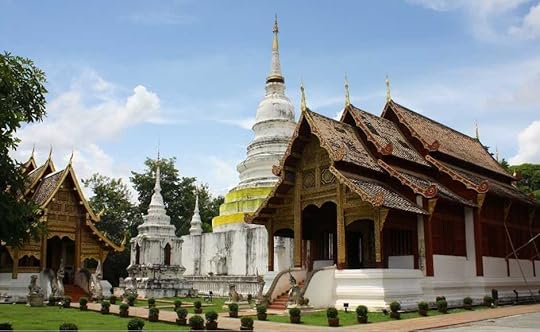 The Temple of The Lion Buddha – Wat Phra Sing – is one of the most highly visited temples
The Temple of The Lion Buddha – Wat Phra Sing – is one of the most highly visited templesAs was royal practice at the time of the Lanna Kingdom, the fifth ruler, King Phayu, ordered construction of the temple in 1345 to house the ashes of his father, King Khamfu.
In 1367 the temple became the sacred home of a Buddha image called the Phra Sing (Sihingh) which is now the second most important Buddha image in Thailand after the Wat Phra Kaew ‘Emerald Buddha’ now enshrined in Bangkok.
The classic Lanna architecture of this temple is also revered for its beautifully and sympathetically restored intricate wood carvings and its beautiful murals.
The smaller surrounding chapels and shines that were later added and also restored make up this important archaeological and prestigious religious site.
 The temple is the sacred home to Buddha image Phra Sing (Sihingh)
The temple is the sacred home to Buddha image Phra Sing (Sihingh)During the Songkran festival in April, Phra Sing is paraded in a procession around old Chiang Mai town and locals sprinkle the Buddha image with water, to bring upon them good luck and prosperity according to the traditional faith.
I found my daytime visit to Wat Phra Sing enchanting and so I also visited this temple after dark when it was beautifully illuminated.
HOW TO GET TO WAT PHRA SING
Located within the old city walls in the centre of Chiang Mai.
The entrance is at the end of Ratchadamnoen Road.
Address: 2 Sam Lan Road Mueang Chiang Mai, Chiang Mai
WAT CHIANG MANAmazingly, Wat Chiang Man is the oldest temple in Chiang Mai.
It was commissioned in 1296 by King Mengrai of Lanna Kingdom.
This temple highly revered and really worth visiting for several reasons aside for its grand age.
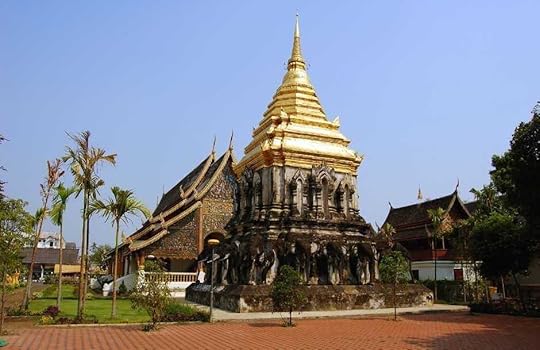 Wat Chiang Man is the oldest temple in Chiang Mai
Wat Chiang Man is the oldest temple in Chiang MaiThe magnificent ordination hall enshrines an ancient Buddha image named Phra Kaew Khao.
It’s home to The Crystal Buddha (Phra Sae Tang Khamani) and The Marble Buddha.
Wat Chiang Man is famous for its chedi with its mixture of Lanna and Sinhalese inspirations.
It is also unique with its supporting buttress decorated with rows of stone elephant carvings.
HOW TO GET TO WAT CHIANG MAN
Wat Chiang Man can be found in the northeast corner of the old city.
Address: 171 Ratchapakhinai Rd, Tambon Si Phum, Mueang Chiang Mai District
WAT SUAN DOKWat Suan Dok means “flower garden temple” as it was previously situated within the walls of a Royal flower garden.
Originally, in the 14th century, when the temple was constructed by King Kue Na of the Lanna Kingdom – the temple was known as Wat Bupparam Dok Mai.
 Wat Suan Dok means “flower garden temple”
Wat Suan Dok means “flower garden temple”Today, Wat Suan Dok is a Buddhist university where visitors can interact and chat with the monks.
The student monks are very happy to practice speaking English and to answer questions about Buddhism, temple customs, and the culture of the Thai people.
 Wat Suan Dok is a temple with a Buddhist university
Wat Suan Dok is a temple with a Buddhist universityHOW TO GET TO WAT SUAN DOK
Address: 139 Suthep Rd, Tambon Su Thep, Mueang Chiang Mai District
WAT LOK MOLIWat Lok Moli is known for its ancient architecture and its impressive chedi containing the ashes of several Kings of the Mengrai dynasty who ruled the Lanna Kingdom from the end of the 13th century.
Set in beautiful grounds, the temple is otherwise a historical mystery as it is not known exactly when it was temple was built only that it is first mentioned in a charter in 1367.
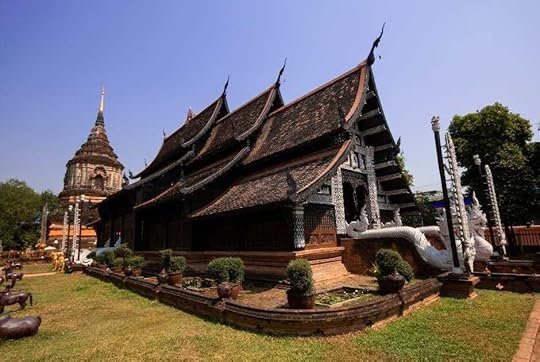 Wat Lok Moli is known for its ancient architecture and its impressive chedi
Wat Lok Moli is known for its ancient architecture and its impressive chediHOW TO GET TO WAT LOK MOLI
Wat Lok Moli is situated on the north side of the north moat surrounding the old part of the city.
Address: 298/1 Manee Nopparat Rd, Chiang Mai
WAT SRI SUPHAN (SILVER TEMPLE)Chiang Mai’s ‘Silver Temple’ is believed to have been founded in the 1500’s during the reign of King (Phaya) Kaew or Mueangkaew (1495–1525), the eleventh ruler of the Mangrai Dynasty.
Today the temple is famous for its intricate silver decorations and its silver adorned ordination hall.
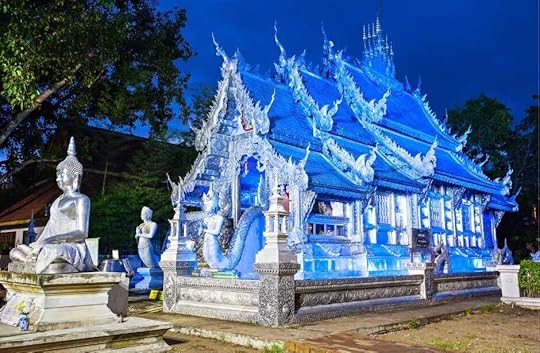 The temple is famous for its intricate silver decorations
The temple is famous for its intricate silver decorationsIt is also known for its unique Buddhist art and traditional silver workshops.
The temple material is actually a mix of aluminium and silver.
Although some decorative parts are confirmed 100% silver.
I enjoyed visiting this beautiful temple after dark when it was illuminated with different coloured lights.
Located outside the old walled city just north of the Chiang Mai gate.
HOW TO GET TO WAT SRI SUPHAN
Address: 100 Wualai Rd, Haiya Sub-district, Mueang Chiang Mai District
CHAING MAI – MY TOP TEMPLES TOUR THE ALMS-GIVING RITUAL (TAK BAT)The alms-giving ritual, known as “Tak Bat,” is a traditional practice observed by Buddhist monks and laypeople throughout Thailand, including in Chiang Mai.
This daily ritual is a significant aspect of the Buddhist way of life, reflecting the interdependence between monks and the lay community.
During the Tak Bat, there is an Early Morning Procession of monks leaving their temples typically around dawn (5:30 to 6:30am) to walk silently through the streets of the city.
They carry alms bowls, which are round, metal containers used to collect food offerings.
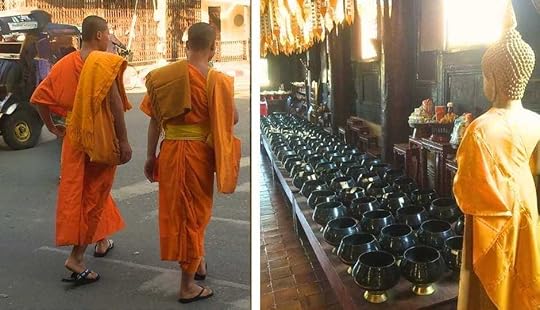 Monks and alms bowls in Chiang Mai
Monks and alms bowls in Chiang MaiLocal residents and devotees wait along the monks’ route.
I saw them kneeling or standing with heads bowed as a sign of respect as they offered freshly prepared food, fruits, rice, and sometimes other essentials like toiletries or medicines.
I am aware that women (or children) should never touch a monk.
So offerings are either placed on a table for the monk to serve him or her self or placed on a cloth between the woman and the monk.
Only men can place offerings directly into the monks’ alms bowls.
Alms-giving is a spiritual practice and the act of generosity in giving alms is considered a way for people to earn good karma for themselves and a way to support the monks in their community.
For monks, collecting alms is a practice of humility, gratitude, and detachment from material possessions.
It allows them to focus on their spiritual journey without being burdened by the need to earn a livelihood.
After receiving alms, the monks often chant blessings or offer silent prayers in gratitude.
So, in cities like Chiang Mai, alms-giving is not only a religious practice but also a cultural heritage and offers a glimpse into the deeply rooted Buddhist traditions and way of life that have been preserved over centuries.
I found it both wonderful and humbling to respectfully observe Tak Bat as a visitor to Thailand.
CHAING MAI – MY TOP TEMPLES TOURTEMPLE ETIQUETTE IN THAILAND
Visiting temples in Thailand is a culturally enriching experience but to show respect for the sacred spaces there is a temple etiquette and I’ve listed the main ones here:
Always take off your shoes before entering the temple buildings.
There are usually designated areas to leave your shoes outside.
Everyone is expected to dress conservatively.
Women should keep shoulders and knees covered.
Avoid wearing sleeveless tops, shorts, or short skirts.
I was actually wearing shorts when I visited one of the temples but for just a few Bhat I was able to ‘rent a skirt’ from a young local entrepreneur at the temple gate with which to cover my knees. I was grateful!
Always maintain a quiet demeanour and speak in hushed tones.
Remember that temples are places of worship and meditation.
No public displays of affection so do refrain from kissing or hugging.

Feet are considered the lowest part of the body and pointing them at people or religious objects is disrespectful.
Avoid pointing your feet by sitting with your feet tucked beneath you.
Respect religious objects and don’t touch or climb on statues or religious artefacts.
Avoid taking photos where prohibited.
Women should not touch monks or hand anything directly to them.
Use a male intermediary or place the object on a cloth or table.
Use the traditional Thai greeting by pressing your palms together in a prayer-like gesture and slightly bowing.
Always check if photography is allowed especially inside the temple buildings.
If permitted, be discreet and take photos quietly and without flash.
It’s customary to make a small donation when visiting a temple.
CHAING MAI – MY TOP TEMPLES TOUR
BEST TIME TO VISIT CHAING MAI?
See my post on The Best (and worst) Times to Visit Thailand
Have you been to Thailand?
Have you been to Chiang Mai?
Do you love to visit temples?
Let me know!
I’d love to hear from you so leave a comment.

I RECCOMEND TRAVEL INSURANCE – GET A NO OBLIGATION QUOTE TODAY

The post Thailand: Chiang Mai – My Top Temples Tour appeared first on The Backpacking Housewife.
May 15, 2024
Thailand: The Best and Worst Time to Visit Thailand
Personally, I love to visit Thailand at any time of the year and I have done so many times and in all seasons.
If you’re planning a trip to Thailand then it’s worth knowing the kingdom experiences three main weather seasons.
The cool season, the hot season, and the rainy (monsoon) season.
That sounds pretty simple to navigate but did you know there are two monsoon seasons affecting Thailand?
Between June and October, the monsoon rains affect the northern, central and southwest regions of Thailand.
But, between October and December, the southeast coast and the Gulf of Thailand has a separate monsoon cycle.
In this post, I’m going to explain how the best and worst time to visit Thailand can be determined by the seasons, the monsoons, the regions, the most popular Thai holidays, and your own preferences.
So you can choose your very best Thai time to visit this fabulous country!
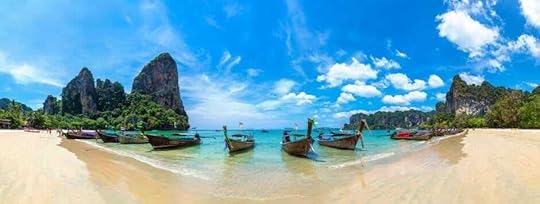 The best and worst time to visit Thailand can be determined by the seasonsSEASONS IN THAILANDTHAILAND IN RAINY SEASONTHAILAND BY SEASON AND REGIONNORTHERN REGIONNORTHEASTERN REGIONCENTRAL REGIONEASTERN REGIONSOUTHERN REGIONNORTHWEST GULF OF THAILANDWEST COAST GULF OF THAILANDEAST COAST GULF OF THAILANDSEASONAL FESTIVALS IN THAILANDTHE BEST AND WORST TIME TO VISIT THAILAND
SEASONS IN THAILAND
The best and worst time to visit Thailand can be determined by the seasonsSEASONS IN THAILANDTHAILAND IN RAINY SEASONTHAILAND BY SEASON AND REGIONNORTHERN REGIONNORTHEASTERN REGIONCENTRAL REGIONEASTERN REGIONSOUTHERN REGIONNORTHWEST GULF OF THAILANDWEST COAST GULF OF THAILANDEAST COAST GULF OF THAILANDSEASONAL FESTIVALS IN THAILANDTHE BEST AND WORST TIME TO VISIT THAILAND
SEASONS IN THAILAND
Peak Tourist Season (December and January) While the weather is fantastic during this time, it’s also when Thailand sees the highest number of tourists.
Popular destinations can get crowded and accommodation prices tend to be at their peak so booking in advance is essential if you plan to visit during this period.
Cool Season (November to February) This is considered the most pleasant time to visit Thailand with lower humidity and cooler temperatures.
Daytime temperatures typically range from 20°C to 30°C (68°F to 86°F) making this season ideal for beach holidays, water activities, and all other outdoor adventures including sightseeing.
 November on Koh Kradan – The Andaman Sea Thailand
November on Koh Kradan – The Andaman Sea ThailandShoulder Season #1 (February to April) This period marks the transition from the cool season to the hot season.
Temperatures are starting to rise but it’s still relatively comfortable compared to the peak of the hot season.
This is a great time to visit if you want to avoid the crowds of the cool season but still enjoy relatively pleasant weather.
Hot Season (March to May) The hot season in Thailand is characterised by high temperatures and humidity.
Daytime temperatures can soar above 30°C (86°F) and sometimes even reach 40°C (104°F) in certain areas like the central plains and northern regions.
Thailand’s hot season can be particularly uncomfortable for some travellers.
It’s advisable to seek shade and stay hydrated during this time.
Outdoor activities can be challenging in hot season and you’re likely to find yourself taking refuge in air-conditioned places.
 The Backpacking Housewife on Koh Tao – Gulf of Thailand
The Backpacking Housewife on Koh Tao – Gulf of ThailandRainy Season (June to October) The rainy season brings heavy rainfall and occasional thunderstorms to much of Thailand.
While the rain can cool things down a bit, humidity levels remain high, and outdoor activities can be affected.
Flooding can occur in low-lying areas and certain regions like the Andaman coast and the Gulf of Thailand – especially in September and October – which are typically the wettest months.
But, of course, the rainy season also brings lush and green landscapes and fewer crowds.
This makes rainy season a good time to explore certain regions, especially the north and northeast.
It might rain a lot – it could rain every day – but it’s unlikely to rain all day!
 It could rain every day – but it’s unlikely to rain all day!
THAILAND IN RAINY SEASON
It could rain every day – but it’s unlikely to rain all day!
THAILAND IN RAINY SEASON
I’ve spent the entire month of June in rainy season on Koh Chang.
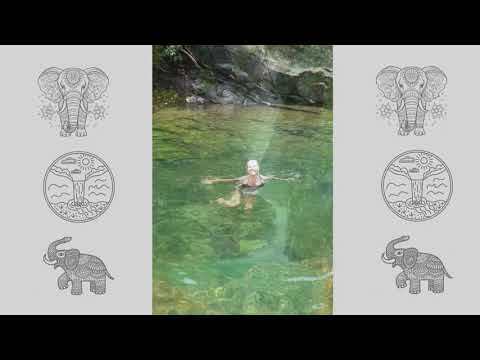
Koh Chang in Rainy Season in less that 1 minute!
I’ve also experienced several months of rainy season on Koh Tao – often our destination of choice for later in the year – for Christmas and New Year and for scuba diving.
Koh Tao is known as the very best place in Thailand to learn to scuba dive.
Those of you who’ve been following my travel posts will know that over the ten years that we’ve been travelling the world, the backpacking husband has become a PADI IDC Staff Instructor and now teaches scuba professionals the world over.
 The backpacking husband is a PADI IDC Staff Instructor
The backpacking husband is a PADI IDC Staff InstructorShoulder Season #2 (Late October to Early November) Mostly, I’ve enjoyed being in Thailand during the shoulder seasons when it’s likely to be less crowded, accommodations tend to be less expensive, and conditions are not quite so uncomfortably hot as in the hot season.
In Thailand, the shoulder seasons fall over several weeks in the transition periods between the cool season and hot season and the monsoon.
 Shoulder Season at Long Beach Koh Lanta – Andaman Sea Thailand
THAILAND BY SEASON AND REGION
Shoulder Season at Long Beach Koh Lanta – Andaman Sea Thailand
THAILAND BY SEASON AND REGION
Also, Thailand’s diverse geography and climate can result in variations in weather patterns across different regions of the country.
In the list below we take a look at the regions of Thailand with regular cyclic weather seasons and those with patterns of seasonal anomalies.
It’s certainly worth knowing about these anomalies if you are planning to visit the coastal regions and the islands of the Gulf of Thailand.
 Thailand’s diverse geography and climate can result in variations in weather patterns
NORTHERN REGION
Thailand’s diverse geography and climate can result in variations in weather patterns
NORTHERN REGION
(Chiang Mai, Chiang Rai, Mae Hong Son)
Cool Season: November to February. Pleasant temperatures, low humidity, and clear skies make this the best time to visit the northern region as it is perfect for outdoor activities and exploring.
Hot Season: March to May. Temperatures rise significantly, and humidity levels increase. Can be uncomfortably hot with high temperatures and low humidity.
Smokey Season: January to March. This is infamously known as the smoky or burning season in Chiang Mai. This is a time of poor air quality in the region due to agricultural fires being lit to prepare land for farming. To make matters worse this unregulated practice is also implemented in nearby Myanmar and Laos and the smoke blows into Northern Thailand.
Rainy Season: June to October. Heavy rainfall can occur, especially in the mountainous areas, resulting in lush green landscapes.
 The Backpacking Housewife in Chiang Mai during January
NORTHEASTERN REGION
The Backpacking Housewife in Chiang Mai during January
NORTHEASTERN REGION
(Isaan)
Cool Season: November to February. Temperatures are milder, making it a comfortable time to visit. These conditions offer relief from the region’s typically hot and dry climate, making it ideal for travel.
Hot Season: March to May. High temperatures and dry conditions are typical during this time.
Rainy Season: June to October. Heavy rainfall is more pronounced in this region compared to others and flooding can occur in low-lying areas. Outdoor activities can be challenging.
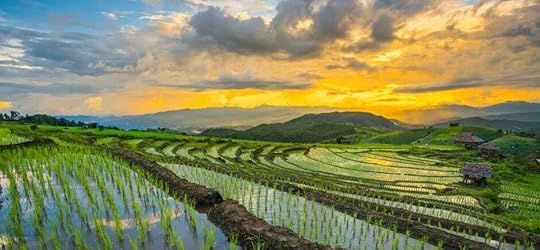 Thailand’s Northern Region
CENTRAL REGION
Thailand’s Northern Region
CENTRAL REGION
(Bangkok, Ayutthaya, Sukhothai)
Cool Season: November to February. Temperatures are relatively cooler and more pleasant. This is the most comfortable time for exploring historical sites and enjoying outdoor activities.
Hot Season: March to May. High temperatures and humidity levels characterize this period. This can be an uncomfortably hot time especially in urban areas like Bangkok.
Rainy Season: June to October. Rainfall is common, especially in the latter part of the season, but it’s usually less intense compared to other regions.
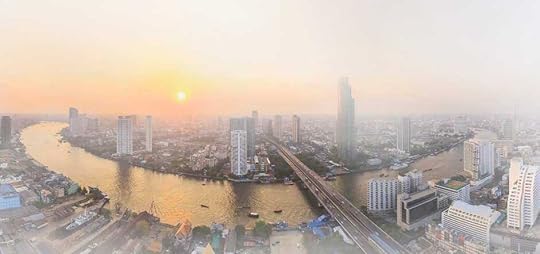 Hot Season (March to May) can be uncomfortable especially in urban areas like Bangkok
EASTERN REGION
Hot Season (March to May) can be uncomfortable especially in urban areas like Bangkok
EASTERN REGION
(Pattaya, Ko Samet)
Cool Season: November to February. Temperatures are comfortable, and humidity levels are lower offing pleasant weather for beach activities and island hopping.
Hot Season: March to May. High temperatures and humidity prevail, making it ideal for beach activities.
Rainy Season: June to October. Rainfall can be heavy at times making beach outings less enjoyable. But the region’s coastal areas may experience less rain compared to other parts of the country.
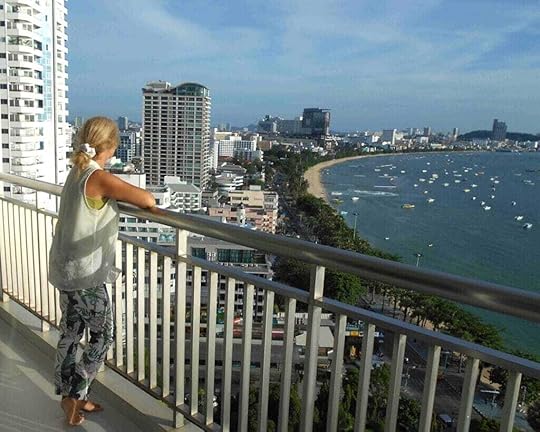 The Backpacking Housewife in Pattaya Thailand
SOUTHERN REGION
The Backpacking Housewife in Pattaya Thailand
SOUTHERN REGION
(Phuket, Krabi)
Cool Season: November to February. Pleasant weather with lower humidity levels, clear skies and comfortable temperatures, making this an excellent time to visit the beaches.
Hot Season: March to May. High temperatures and humidity are common, but sea breezes provide some relief.
Rainy Season: June to October. Heavy rainfall and occasional storms are typical, especially on the west coast, affecting beach activities and water sports.
 31st October: Waiting for a longtail boat from Krabi to Railay Beach Thailand
NORTHWEST GULF OF THAILAND
31st October: Waiting for a longtail boat from Krabi to Railay Beach Thailand
NORTHWEST GULF OF THAILAND
(Koh Samui, Koh Phangan, Koh Tao, Surat Thani)
I mentioned previously that the specifics of weather in Thailand can vary slightly depending on the region especially on the Gulf of Thailand.
So, if your Thai destination of choice is the northwest coast on the Gulf side of Thailand, where you will find the islands of Koh Samui, Koh Phangan and Koh Tao – this is where the rainy season arrives much later in the year.
Here, the rainy season in the northwest starts in late October and continues into December or January.
Although, the worst of the rain is usually over by the middle of December.
 Celebrating Christmas on Koh Tao – Gulf of Thailand
WEST COAST GULF OF THAILAND
Celebrating Christmas on Koh Tao – Gulf of Thailand
WEST COAST GULF OF THAILAND
(Hua Hin, Pranburi, Cha Am)
Hua Hin and the west coast of the Gulf of Thailand also experiences a slightly different rainy season than the mainland and opposite side of the peninsula with the heaviest rain falling in September and October.
Hua Hin’s dry season runs from November through March to April.
 December: Enjoying the West Gulf Coast dry season in Hua Hin
EAST COAST GULF OF THAILAND
December: Enjoying the West Gulf Coast dry season in Hua Hin
EAST COAST GULF OF THAILAND
(Koh Chang, Koh Kood)
The islands of Chang and Kood on the eastern side of the Gulf of Thailand are also subject to slightly different weather patterns and unusually they experience similar weather patterns to the coast and Islands of The Andaman Sea with a rainy season between May and October.
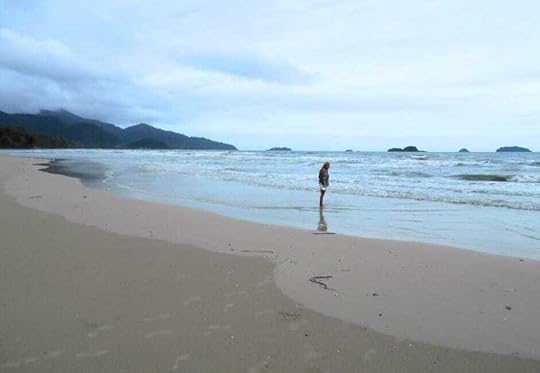 East Coast Gulf: Koh Chang in mid-June and I have the beach to myself
SEASONAL FESTIVALS IN THAILAND
East Coast Gulf: Koh Chang in mid-June and I have the beach to myself
SEASONAL FESTIVALS IN THAILAND
Chinese New Year (January) While not exclusively Thai, Chinese New Year is widely celebrated in Thailand, especially in areas with large Chinese communities such as Bangkok, Phuket, and Chiang Mai. Festivities include dragon dances, fireworks, and traditional Chinese rituals.
Songkran Festival (April) If you’re interested in experiencing Thai culture and traditions, visiting during Songkran, the Thai New Year festival, can be a vibrant and exciting time. It’s celebrated with water fights and street parties and various festivities across the country. It’s one of the most energetic and fun-filled festivals in Thailand.
Rocket Festival Bun Bang Fai (May) Held in northeastern Thailand, particularly in Yasothon and Kalasin provinces, it features large bamboo rockets being launched into the sky to encourage rainfall for the upcoming planting season.
Phi Ta Khon Ghost Festival (June or July) Held in the Dan Sai district of Loei Province, usually in, Phi Ta Khon features colourful masks, traditional dances, and lively processions. It’s a unique blend of Buddhist and animist beliefs.
Vegetarian Festival (September or October) Celebrated primarily by the Thai-Chinese community, particularly in Phuket, this festival usually occurs in Participants observe a strict vegetarian diet and perform various rituals to cleanse the body and mind.
Loi Krathong Festival (November) Another cultural highlight, Loi Krathong, involves floating decorative lanterns on waterways to pay respects to the water spirits. It’s a beautiful and atmospheric festival, particularly in places like Chiang Mai and Sukhothai.
King’s Birthday (Father’s Day) Celebrated on December 5th, the King’s Birthday is a national holiday and a day of reverence and celebration for the Thai people. It’s also observed as Father’s Day in honour of King Bhumibol Adulyadej, who was considered the father of the nation.
 Sunset over Sairee Beach on Koh Tao ThailandTHE BEST AND WORST TIME TO VISIT THAILAND
Sunset over Sairee Beach on Koh Tao ThailandTHE BEST AND WORST TIME TO VISIT THAILANDI think we’ve established now that the best time or the worst time to visit Thailand is entirely down to you and your preferences and your availability!
Have you visited Thailand?
Is Thailand on your travel wish list?
What time of year would you travel to Thailand?
Let me know?
Leave a comment or get in touch!

THE BACKPACKING HOUSEWIFE RECOMMENDS TRAVEL INSURANCE
I USE AND RECOMMEND BOOKING DOTCOM FOR FINDING GREAT ACCOMODATIONS
The post Thailand: The Best and Worst Time to Visit Thailand appeared first on The Backpacking Housewife.
May 6, 2024
Thailand: Koh Chang in Rainy Season
In Thailand, the month of June can be tricky for travellers heading to the islands as it’s the start of rainy season.
But if you’re a traveller who prefers to travel out of season because you like to avoid the crowds and pay less for your accommodation – and you don’t mind it raining rather a lot – one such a place I can recommend to you is Koh Chang.
Koh Chang – meaning Elephant Island – is Thailand’s third largest island.
It’s to be found in the Mu Ko Chang National Park on the eastern side of the Gulf of Thailand.
On Koh Chang in rainy season, you can usually get out of season bargains on accommodation and as a bonus, have much of this island paradise to all to yourself.
In high season, this island is popular with Thai’s on holiday, but it is still very much off radar for most tourists coming to Thailand.
So it still feels unspoilt and authentic.
I can imagine the Koh Chang today is something like the islands on the other side of the Gulf of Thailand – Koh Samui, Koh Phangan, and Koh Tao – used to be a couple of decades ago.
Before they became so accessible to mass tourism and popular with tourists.
Koh Chang still feels like a secret destination.
At least, in rainy season, it does!
The island is easily accessible by a 30 minute ferry trip from Mainland pier (Ao Thammachart) to Koh Chang Pier (Ao Sapparot) and unlike many island ferries who cease in rainy season – like those servicing the islands of the Andaman Sea of Thailand – the Koh Chang Ferries operate from early morning until the evening and for 365 days a year – even on Thai holidays.
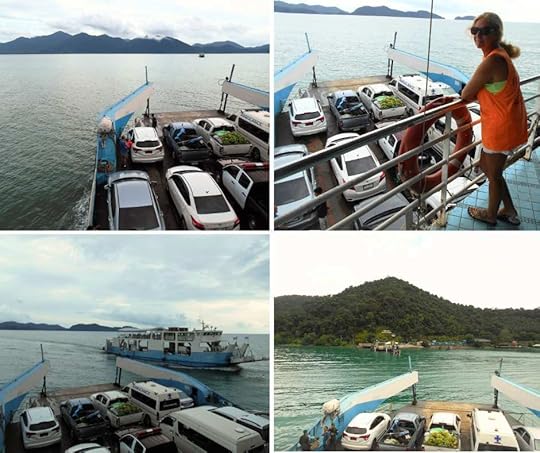 On the ferry over to Koh Chang
On the ferry over to Koh ChangI’ve included details on various ways to get to Koh Chang – and how I got to Koh Chang with a route map – at the end of this post.
As well as being unspoiled, in my opinion, this beautiful island – even more so in rainy season – is a delight because it is mostly devoid of tourists and offers weary travellers that wonderful combination of peace and tranquillity and fabulous but affordable accommodations.
 The interior of the island is covered in dense jungle and tropical rain forest WHERE TO STAY ON KOH CHANG
The interior of the island is covered in dense jungle and tropical rain forest WHERE TO STAY ON KOH CHANGThere is a variety of fabulous accommodations and for all budgets on Koh Chang.
Much of the accommodation is concentrated around White Sand Beach but there are also options in other areas of the island.
I stayed on Koh Chang for the entire month of June and, for the first two weeks, we stayed in a deluxe room at the gorgeous Ramayana Koh Resort and Spa – now known as Annika – which is not too far from Klong Prao Beach.
This hotel offered rooms in beautiful tropical gardens, with a swimming pool, a restaurant, and bar.
We booked this stay with (affiliate link) Booking Dotcom.
For our second two weeks on Koh Chang, we decided to move a short distance away to another hotel, but this was only because the prices at Annika had risen sharply (Thai holiday?) for the last two weeks of June compared to the first two weeks.
We then stayed at Bhu Tarn Koh Chang Resort & Spa and again found the best rates were at (affiliate link) Booking Dotcom.
WHAT TO DO ON KOH CHANG IN RAINY SEASONWhen it rained – it’s worth knowing that during June on Koh Chang it is likely to rain every day but not all day and it’s a tropical island so it’s still very warm anyway!
 On Koh Chang it is likely to rain every day… but not all day
On Koh Chang it is likely to rain every day… but not all day We were on Koh Chang to rest and recharge and cut our costs after lots of travel around Southeast Asia.
I had some writing deadlines to meet – so we didn’t mind spending time relaxing in our room or sitting watching the rain from our balcony while drinking a ‘Chang’ beer.
It was also still enjoyable to swim in the hotel pool during the afternoon downpours.
When it didn’t rain – and the sun came out – there was the opportunity to sunbathe by the pool.
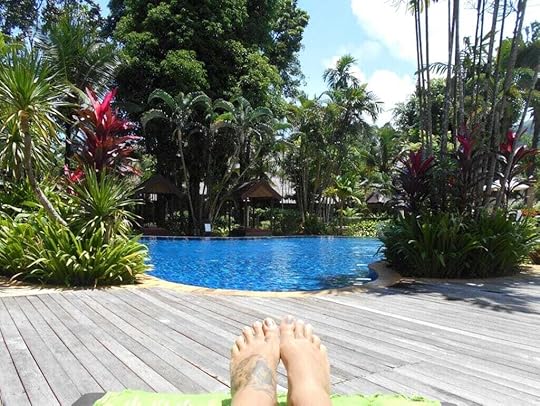 Sunny days on Koh Chang were spent sunbathing at the hotel pool
Sunny days on Koh Chang were spent sunbathing at the hotel poolWe could walk into town for lunch or find an interesting place to stop and have a drink.
When it’s not raining on Koh Chang it’s also lovely to walk along the beach that we’d had all to ourselves.
THE BEAUTIFUL BEACHES OF KOH CHANGKoh Chang’s beaches are stunningly beautiful and each offers its own unique charm and atmosphere.
But, of course, during Koh Chang in rainy season, you should be aware that many beachside places are closed due to lack of tourists in low season.
White Sand Beach (Hat Sai Khao) is one of the most developed beaches on the island, featuring powdery white sand and crystal-clear waters.
Lonely Beach (Hat Tha Nam) as the name suggests used to be a secluded spot. It has become increasingly popular with backpackers and budget travellers so, in high season, Lonely Beach is the place to find beach bars and nightlife.
Klong Prao Beach is less crowded compared to White Sand Beach but still offers a good range of resorts, restaurants, and water activities. With its stretch of golden sand is ideal for those seeking tranquillity and relaxation.
Kai Bae Beach nestles between Klong Prao and Lonely Beach, Kai Bae Beach is known for its picturesque setting and shallow waters, making it suitable for families with children. It also offers a variety of accommodations, from budget bungalows to upscale resorts.
Bang Bao Beach is located near the traditional fishing village of Bang Bao where you can take boat trips to nearby islands. This beach offers a more rustic and authentic experience with its wooden stilt houses and local seafood restaurants.
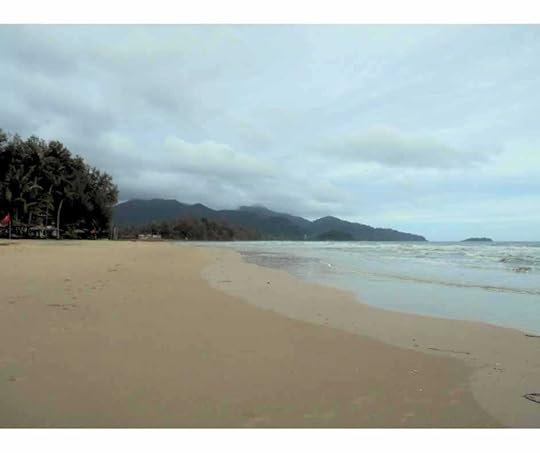
 Wonderful Klong Plu Waterfall
Wonderful Klong Plu WaterfallOne afternoon, we took a trip inland to walk through the jungle and to visit a wonderful waterfall.
Unlike many of the more remote and inaccessible waterfalls on Koh Chang, Klong Plu Waterfall is on the southern tip of the island and is easy to reach along a well-marked jungle trail.
The trek itself is a wonderful experience as it leads through lush tropical rainforest.
I recommend and wore water shoes with some grip as in rainy season the path can be muddy and slippery.
The approximately thirty-metre-high waterfall cascades down a series of rocky tiers, creating several deep and natural pools in which to sit or to swim, which is wonderfully refreshing after the sweaty and humid jungle hike!
There is a small entrance fee to access the waterfall but there are also toilet facilities on site.
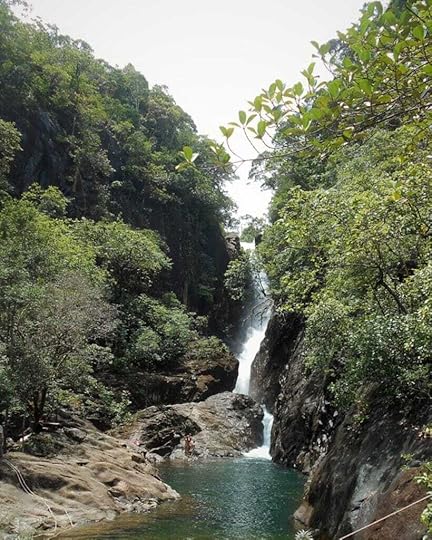 Klong Plu Waterfall
Klong Plu Waterfall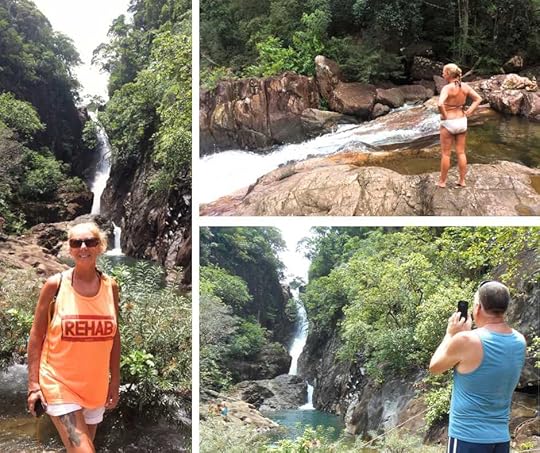 At Klong Plu Waterfall on Koh ChangFABULOUS FIREFLY EXPERIENCE
At Klong Plu Waterfall on Koh ChangFABULOUS FIREFLY EXPERIENCEOne evening, we took a trip out to the Salak Khok Mangroves for a meal in a beautiful waterside restaurant and to take a boat out to see fireflies in the night sky.
The very best time to see the fireflies is in rainy season!
We had the most incredible experience floating in a small boat and switching off our torches to watch those tiny fireflies lighting up the darkness all around us. Magical!
I didn’t take any photos but came across this artwork that perfectly encapsulated the experience.
 Fireflies at Ochanomizu by Kobayashi Kiyochika (Japan Circa 1880) Public DomainAMAZING THAI FOOD ON KOH CHANG
Fireflies at Ochanomizu by Kobayashi Kiyochika (Japan Circa 1880) Public DomainAMAZING THAI FOOD ON KOH CHANGBecause Koh Chang is primarily popular with Thai people for their holidays, the food on Koh Chang is fantastic and authentic Thai food – which we love and was such a highlight!
It’s also incredibly affordable.
We ate lots of delicious food at street carts and small eateries in town and we took a taxi or a songthew out to some of the bigger restaurants by the beach or further inland by the mangroves.
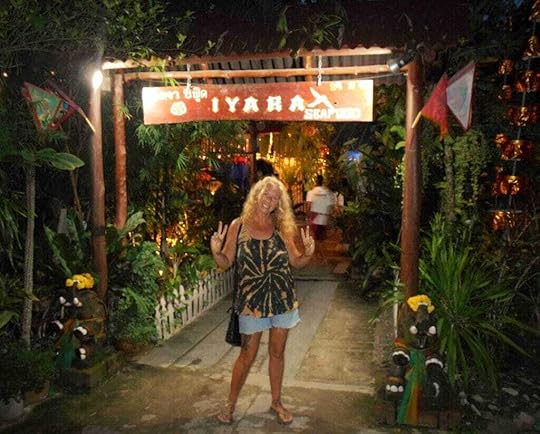 At IYARA Seafood Restaurant on Koh ChangTHE ELEPHANTS OF ELEPHANT ISLAND
At IYARA Seafood Restaurant on Koh ChangTHE ELEPHANTS OF ELEPHANT ISLANDKoh Chang is known in Thai as Elephant Island (because its shape resembles an elephant’s head) but I was very excited to see there actually are elephants on the island.
I was amazed, on my first day on the island, to see an elephant walking down the street with its mahout (handler) sitting on its neck.
I watched it stroll right past me into a field next to our hotel, where it joined several other elephants who were all grazing there, in their in the same way you’d usually see cows in a pasture.
But, during my time on Koh Chang, I also saw elephants wearing chains in roadside camps that were offering Elephant Trekking and Elephant Riding experiences to tourists – and this horrified me.
I personally don’t think elephant riding is ethical under any circumstances.
I quickly realised (disclaimer – as far as I know) there are no ‘Elephant Sanctuaries’ on Koh Chang and so I would urge you to be discerning about any Elephant experiences offered to you on Koh Chang.
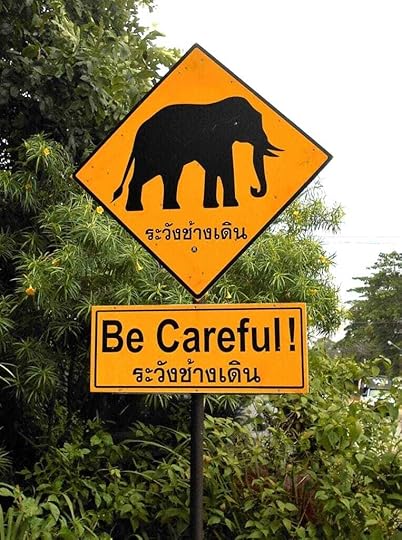 Koh Chang is known in Thai as Elephant Island HOW TO GET TO KOH CHANG
Koh Chang is known in Thai as Elephant Island HOW TO GET TO KOH CHANGOur journey to Koh Chang is an experience in itself, as we decided it was best for us in respect of convenience and cost to fly into Pattaya, stay overnight, then take a bus/ferry/bus combo to our accommodation on Koh Chang.
If you haven’t travelled around Thailand before then you might not realise that it’s easy and cheap to travel around on the mainland and to the islands – there are considerations to be made for rainy season of course – especially on the Andaman Sea side of Thailand when ferries and boats shut down.
But, generally, tourist travel in Thailand is so well organised that it kind of spoils you for other countries in Asia where getting around is not so easy at all.
I’m looking at you Philippines!
Koh Chang is in Thailand’s Trat Province on the eastern side of The Gulf of Thailand, 300 km (186 miles) east of Bangkok, approx. 250 km (150 miles) from Pattaya and approx 550 km from the Cambodia border.
But getting to Koh Chang, until fairly recently, has been time consuming.
But there is now a faster (one hour direct flight) and convenient route to Koh Chang via Trat Airport with Bangkok Airways.
You can then buy a ‘door to door’ minibus or a private transfer from the airport to travel by road/ferry/road directly to your accommodation of Koh Chang.
As I mentioned, our route to Koh Chang was via Pattaya City, and after our five and a half hour road trip we enjoyed a thirty minute ferry crossing over to Koh Chang.
On the ferry, we got to stand on deck and chat to a Buddhist monk who we were delighted to meet.
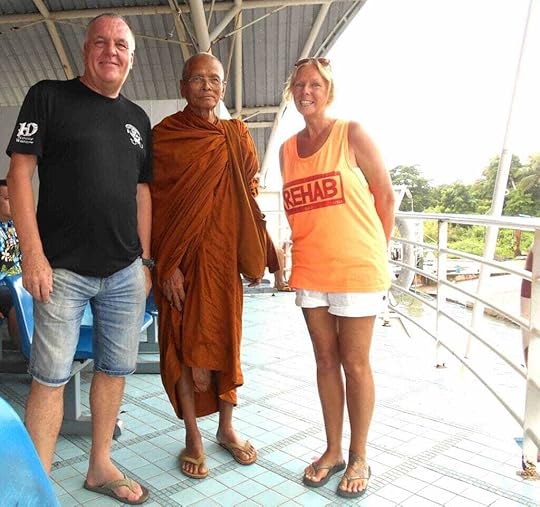
 Our five and a half hour road trip from Pattaya to Koh ChangAN OVERNIGHT IN PATTAYA
Our five and a half hour road trip from Pattaya to Koh ChangAN OVERNIGHT IN PATTAYA As mentioned, we had stayed the night in Pattaya City, before taking a five hour minibus ride down the coastline.
Pattaya has never actually been on my radar as a traveller because the city has an adult party reputation and an infamously explicit red-light district.
But, as we were there, I was curious about the goings on around Walking Street.
So, in the spirit of at least experiencing Pattaya, the backpacking husband and I went out in the early evening to walk around and find a bar for a drink and some people watching.
I’m told Walking Street comes alive after midnight, but even well before then the street was busy and we had our eyes opened, I can tell you!
Viewer discretion is advised!
 In the spirit of at least experiencing Pattaya we found a cocktail bar
In the spirit of at least experiencing Pattaya we found a cocktail bar Walking Street in Pattaya – Viewer discretion is advised!
Walking Street in Pattaya – Viewer discretion is advised!However – I do have very happy and quite sophisticated memories of our stay in Pattaya – because we stayed at the Holiday Inn on Beach Road and it was over-the-top amazing.
We had collect IHG Loyalty Points and qualified for a one-night free hotel stay plus we were delighted to be offered an upgrade to Executive Club which meant complementary cocktails and canapes at the rooftop bar!
We were also upgraded – as per our IHG Platinum Status – to a suite overlooking the beach with a private wrap around balcony.
I was so excited with our luxurious and spacious room that I only wished we could have stayed longer!
 Our suite overlooking Pattaya Beach and had a private wrap around balcony.BEST TIME TO GO TO KOH CHANG
Our suite overlooking Pattaya Beach and had a private wrap around balcony.BEST TIME TO GO TO KOH CHANGThe best time to visit Koh Chang, largely depends on your preferences for weather and activities.
There are only two seasons here – dry season and wet season – and we stayed on Koh Chang in wet (rainy) season.
Dry Season (November to April): This is considered the peak tourist season as the weather is generally sunny and dry.
November to February sees cooler temperatures, making it comfortable for outdoor activities like trekking and exploring.
March and April can get hotter, but it’s still a great time for beach activities and water sports.
Rainy Season (May to October): May to October is the rainy season, characterized by higher humidity and frequent rainfall, particularly from June to September but while it may rain heavily at times, the showers are usually short-lived and followed by sunshine. So, it’s likely to rain every day, but not all day!
The lush vegetation during this time can be beautiful and the waterfalls are at their most impressive during the rainy season.
Activities like jungle trekking (please – not by elephant) can be enjoyable in the cooler, wetter weather.
The fireflies are at their most spectacular in rainy season!
And, accommodation prices may be considerably lower, due to fewer tourists.
Have you been to Thailand in rainy season?
Have you been to Koh Chang?
Let me know!
I’d love to hear from you so leave a comment.


THE BACKPACKING HOUSEWIFE RECOMMENDS TRAVEL INSURANCE
The post Thailand: Koh Chang in Rainy Season appeared first on The Backpacking Housewife.
May 1, 2024
Thailand: Spirit Houses
I’ve spend quite a long time in Southeast Asia over the past ten years of travelling, and one of the things I absolutely love about Thailand, are the spirit houses known as ‘san phra phum’ or ‘shrine of the guardian spirit’.
Spirit houses are such an important part of Thai culture and spirituality.
These miniature shrines that often look like ‘doll’s houses’ are not just decorative because they embody the reverence and respect Thai people have for the unseen forces they believe have influence over their lives.
It is believed they serve as a bridge between the material and spiritual worlds.
They are often ornately decorated and can be found throughout Thailand and in many other countries of Southeast Asia in various locations such as homes, businesses, temples, and even public spaces.
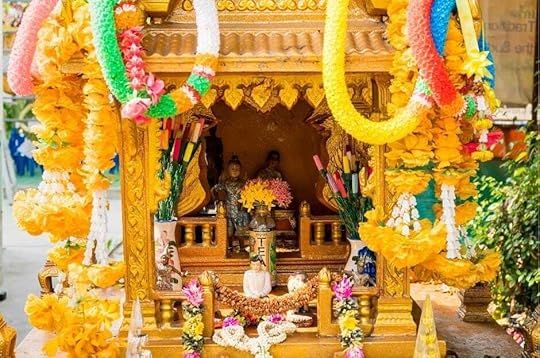 Spirit houses are often ornately decorated
Spirit houses are often ornately decorated

Spirit Houses in Thailand in less than 1 min!WHAT IS A THAI SPIRIT HOUSE?
Spirit houses outside homes are built to provide a shelter for ancestors or guardian spirits or household deities known as ‘phi’ and these spirits are thought to bring protection, prosperity, and good fortune to the property and to its inhabitants.
So, it is believed, if you look after the spirits then they will look after you.
And, it is preferable that the spirits have a dwelling of their own, so they have no need to live inside the main house with the family!
Businesses also often have elaborate spirit houses to attract prosperity and ensure the success of their ventures.
Similarly, public spaces may have communal spirit houses to protect and bless the surrounding area.
Spirit houses come in various sizes, ranging from simple structures to elaborate miniature replicas of traditional Thai architecture.
It doesn’t matter whether you are rich or poor when it comes to providing a spirit with a house – but the wealthier the spirit house owner – then the more likely it is to be adorned with intricate carvings and painted in vibrant colours.
Many spirit homes will have miniature furniture, figurines, and animals.
I do love to peep inside to see these tiny spiritual inhabitants!
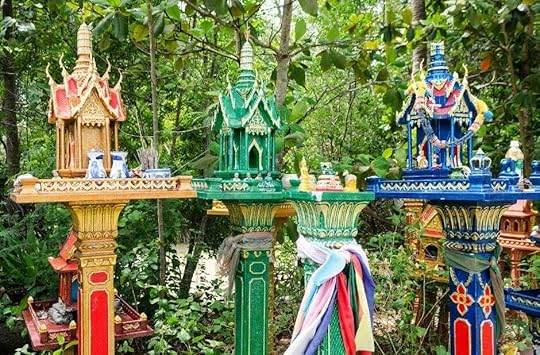 If you look after the spirits then they will look after youWHERE TO PLACE A THAI SPIRIT HOUSE
If you look after the spirits then they will look after youWHERE TO PLACE A THAI SPIRIT HOUSEThe location of a spirit house is always carefully considered and the chosen place – whether at the front of a property or at a corner or a boundary – is believed to ensure harmony between the human and spiritual realms.
Newly build spirit houses are blessed by a monk and he will consult astrology and numerology to decide on the aesthetics and even the colour of the spirit house.
During an elaborate inauguration ceremony, he will formerly invite the guardian spirits still living on the earthly plane to occupy the spirit house.
Regular offerings and rituals are performed to honour the spirits inhabiting the spirit house and these typically include flowers, fruits, incense, and small cups of water or rice.
I have even seen offerings of a bottle of beer – I assume for a deceased and beloved family member who had a penchant for ‘Chang’ during his lifetime!
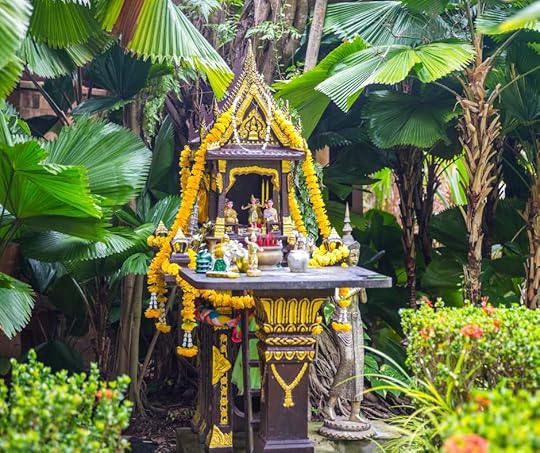 Spirit homes have miniature furniture, figurines, and animals.
Spirit homes have miniature furniture, figurines, and animals.The rituals involving spirit houses often vary depending on personal beliefs and regional customs but often involve prayers and gestures of respect.
In Thailand, the majority of people are Buddhist, but the belief in spirits and spirit worship – known as Animism – has been practiced long before Buddhism arrived in Thailand and is prevalent throughout Southeast Asia.


 Spirit houses also require regular maintenance and care
Spirit houses also require regular maintenance and care There are certain taboos associated with spirit houses, such as never placing them in the shadow of a building or in a disrespectful location and never moving them without a proper ritual and permission.
Spirit houses also require regular maintenance and care as neglecting a spirit house is believed to invite misfortune or displeasure from the spirits.
I have honestly never seen a neglected spirit house!
Owners will often repaint and repair spirit houses, replace offerings several times a day, and perform rituals on significant occasions such as Thai New Year (Songkran) or other religious festivals.
As a westerner, I really enjoy Thailand’s traditions, and appreciate seeing these beautiful spirit houses.

Have you been to Thailand?
Is Thailand on your travel wish list?
Would you like a spirit house outside your home?
Let me know!
Leave a comment in the box below.
The post Thailand: Spirit Houses appeared first on The Backpacking Housewife.
April 30, 2024
Cambodia: War Museum Siem Reap
The War Museum in Siem Reap is the only war museum in Cambodia.
I feel there is always an element of dark tourism in visiting a war museum.
I’ve visited war museums in Ho Chi Minh City in Vietnam, Hiroshima in Japan, and Daegu in South Korea.
As a conscientious traveller, if the opportunity presents itself to visit a museum of war and that has been part of the history of the country I’m exploring, then I’m interested in knowing more about the human aspect of that war.
I feel it adds to my understanding of the culture and my appreciation of the people.
While visiting Siem Reap, Cambodia, for exploring Angkor Wat and the Angkor Archaeological Park, I also managed to take a half day to explore the Floating Villages on Tonle Sap Lake and a couple of hours to visit the War Museum of Cambodia.
The war museum is set in an outdoor area and there’s lots of old military hardware to look at dating back to the WW2 and to the Cambodian Civil War.
 A tank on display at War Museum of Cambodia Siem Reap
A tank on display at War Museum of Cambodia Siem ReapIt’s interesting, but also disturbing, to know all the artillery and weapons on display are authentic and battle worn.
There are lots of old vehicles and tanks too (Russian T54 and T55) and a MIG Fighter Plane.
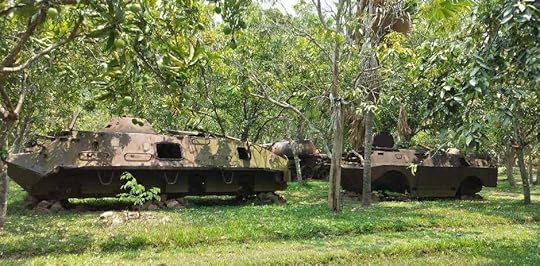 There are lots of old vehicles and tanks at the war museum
There are lots of old vehicles and tanks at the war museumThere are also hand guns and field guns and assault rifles and hand grenades and landmines.
The photographs on display are all rare and original which I found interesting but harrowing.

 All the artillery and weapons on display are authentic
All the artillery and weapons on display are authenticThe information provided on landmines is intended to educate visitors on how these terrible weapons were used and how landmines are still a very big and dangerous problem in Cambodia today.
Many of these still undetected live mines are known to be buried in the rural northwest of Cambodia, in an area known as K5, near to the Thai border.
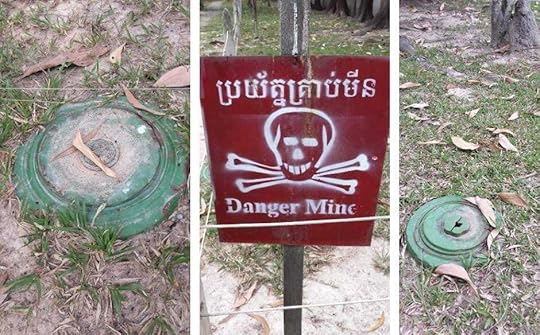
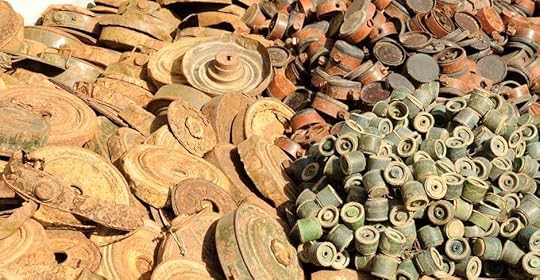 The information provided on landmines is intended to educate visitors
The information provided on landmines is intended to educate visitors The HALO Trust says: “Over 65,000 casualties have been recorded since 1979, resulting with 18,800 people being killed and nearly 45,000 people injured. The threat to the people of Cambodia—from landmines and other dangerous debris left after the war—is extremely high.”
THE CAMBODIAN CIVIL WARThe Cambodian Civil War began in 1967 when the Khmer Rouge gained popularity and support from some Cambodians.
In 1970, a civil coup deposed King Norordom Sihanouk.
The war ended with the victory of the Khmer Rouge in 1975.
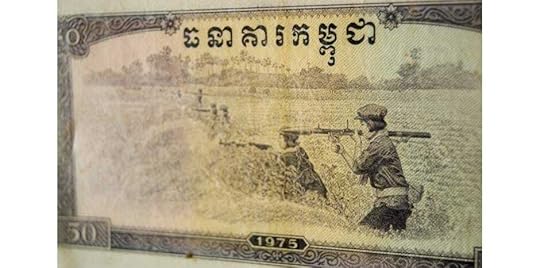 Former Khmer Rouge banknote dated 1975IS THE WAR MUSEUM OF CAMBODIA WORTH A VISIT?
Former Khmer Rouge banknote dated 1975IS THE WAR MUSEUM OF CAMBODIA WORTH A VISIT?We took a tuktuk taxi to visit the war museum and I would say yes – it’s worth a visit.
It’s worth seeing because it’s the only war museum in a country that has witnessed one of the most brutal conflicts in recent history.
And, perhaps because at my age, I can clearly remember the terrible news on our TV screens coming out of Cambodia in the 1960’s and 70’s.
The weapons and artillery in this museum are preserved as a reminder lest we forget the two million Cambodians who died in this horrific conflict.
It’s also worth knowing all the guides at the museum are war veterans.
There is a small entry fee and the museum has a Facebook Page
 What do you think of war museums?HOW TO GET TO THE WAR MUSEUM OF CAMBODIA
What do you think of war museums?HOW TO GET TO THE WAR MUSEUM OF CAMBODIAThe War Museum is easy to reach on National Route 6 between Siem Reap Town and the International Airport.
THE BEST TIME TO VISIT CAMBODIAThe best time to visit Siem Reap, Cambodia, is generally during the cool and dry season from November to February when the weather is cooler.
Daytime temps during this time usually hover around 25°C to 30°C (77°F to 86°F).
Cool and Dry Season (November to February): This is the peak tourist season due to the favourable weather conditions. It’s also a great time for photography as the skies are clear and the light is good for capturing the ancient ruins.
Hot Season (March to May): Temperatures can soar up to 40°C (104°F) during these months. While this is still a popular time to visit, the heat can be quite intense, especially midday. If you visit during this time, plan early morning and late afternoon tours to avoid the hottest parts of the day.
Wet Season (June to October): This is the monsoon season when rainfall is frequent, especially in the afternoons. The advantage of visiting during this period is that the landscape is lush and green, and the tourist crowds are thinner.
Have you ever been to Cambodia?
Is Cambodia on your travel wish list?
What do you think of war museums?
Let me know. I’d love to hear from you.
Leave a comment in the box below!
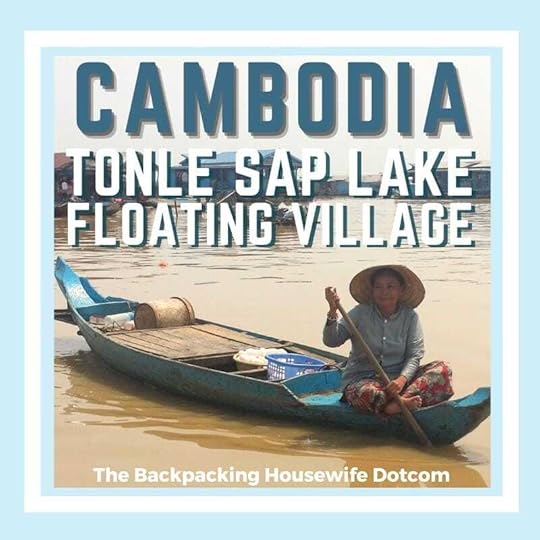
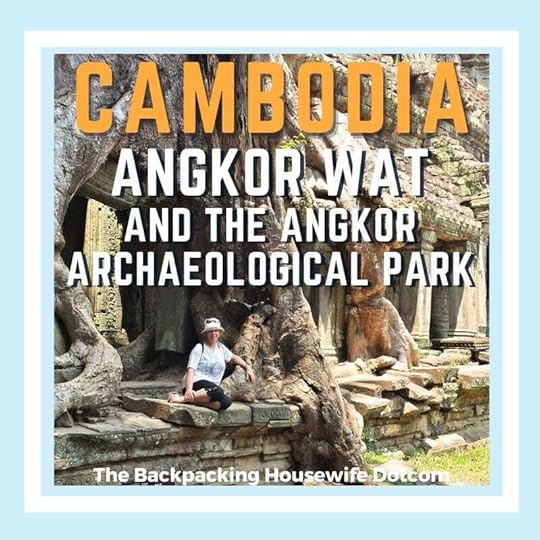
The post Cambodia: War Museum Siem Reap appeared first on The Backpacking Housewife.
April 29, 2024
Cambodia: Tonle Sap Lake – Floating Village
Less than a one-hour drive south from Siem Reap is Tonle Sap Lake – the largest freshwater lake in Southeast Asia – and it provides a home and a livelihood for the three million Cambodian people who live in floating villages on the lake.
This remarkable lake undertakes a dramatic transformation between May to October (the wet season) when flooding fills the lake with water from The Mekong River and it swells to an area of 16,000 sq/km and five times its dry season size.
The flooded lake provides a fertile breeding ground for fish which is one of the most productive freshwater fisheries in the world. The fish caught here provides more than two-thirds of Cambodia’s protein consumption.
During the dry season between November and April the lake’s waters recede and expose wide areas of muddy flats and the people of the floating villages will then move their floating homes and shops and animal housings closer to the shoreline.
 A family living in the Tonle Sap Floating VillageMY VISIT TO THE FLOATING VILLAGE ON TONLE SAP LAKE
A family living in the Tonle Sap Floating VillageMY VISIT TO THE FLOATING VILLAGE ON TONLE SAP LAKEMy visit to the floating village on Tonle Sap Lake was in April, so at the end of the dry season.
We asked our tuktuk driver, who we’d enjoyed the company of for the past three days of sightseeing around Angkor Wat and Angkor Archaeological Park to take us on a half day trip to a floating village.
Luckily for us, he said his cousin had a small boat, and he could arrange a private tour.
Now, if you’ve done any research at all on the floating villages at Tonle Sap Lake then you might have read warnings about local scams and overcharging and begging etc etc.
But, as I mentioned, we’d been with our driver for a few days and we were happy to take up his recommendations.
So, he phoned his cousin, and the cost he quoted to take us on a half day trip out to the lake and on his cousin’s boat seemed entirely reasonable to us. We didn’t need to compare prices with anywhere else or to try to bargain.
It’s important to remember that tourism is important to the local people.
Travel and experiencing a glimpse into other people’s lives is important to us.
So, I feel if you’re quoted a reasonable price for a local service and you want to accept it, I see nothing wrong.
But if you are not sure what seems reasonable, I might suggest you talk to your hotel about local tours and prices, and what you should expect to pay. I would also suggest you look at tours sold by (affiliate link) KLOOK.
 We took a half day boat trip to Tonle Sap Lake Floating VillageTONLE SAP LAKE – FLOATING VILLAGE
We took a half day boat trip to Tonle Sap Lake Floating VillageTONLE SAP LAKE – FLOATING VILLAGEWe reached the Tonle Sap Lake and our driver located his cousin and his boat.
Introductions were made to the cousin who would be our captain and a couple of his deck hands and we all set off down a canal of yellow/brown muddy water in the direction of the vast freshwater lake.
We are told that in Khmer the word ‘Tonle’ means freshwater and ‘Sap’ means lake.
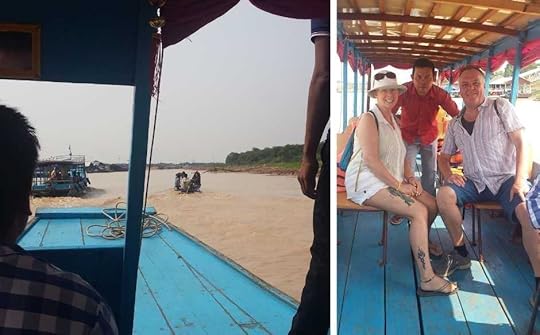 Setting off down the canal leading to Tonle Sap LakeTHE BACKPACKING HUSBAND GETS TO DRIVE THE BOAT!
Setting off down the canal leading to Tonle Sap LakeTHE BACKPACKING HUSBAND GETS TO DRIVE THE BOAT!Along the way, the backpacking husband got to drive the boat – he’s actually a qualified boat captain – although on this occasion I don’t think that mattered!
Can you see in the photo how the accelerator peddle is a chain and string!
Onboard we were treated like new friends and offered refreshments – bottled cold water – bottles of local beer – cigarettes if we wanted to smoke – and some strips of jerky to chew on that our driver had bought from a woman selling the spicy tasting dried meat from a passing canoe!
It was all great fun and we got on well with our captain and his crew.
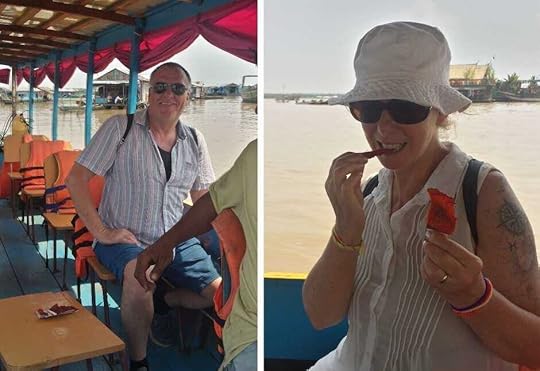 Tasting the beef jerky that may not have been beef!
Tasting the beef jerky that may not have been beef! The backpacking husband gets to drive the boat!THE FLOATING VILLAGES OF TONLE SAP LAKE
The backpacking husband gets to drive the boat!THE FLOATING VILLAGES OF TONLE SAP LAKEThere are three different floating villages on Tonle Sap Lake.
They are known as: Chong Kneas, Kompong Phluk, and Kompong Khelang.
They each offer tourists the opportunity to observe traditional fishing methods, visit local markets, and learn about the rich cultural heritage of the communities living on the lake.
I was amazed to see children happily floating around in their one-person plastic tub boats, following tourists while carrying pet snakes aloft, asking for ‘one dollar!’ to take a photo.
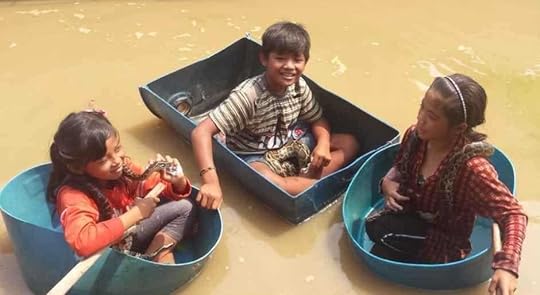 Children asking for ‘one dollar!’ to take a photo – notice the snakes!
Children asking for ‘one dollar!’ to take a photo – notice the snakes!I was fascinated to see floating wooden houses with dogs sitting on porches.
There were floating animal crates and chickens in pens attached to floating houses.
There were floating grocery shops and shops of every kind.
Men in small boats, fishing with nets.
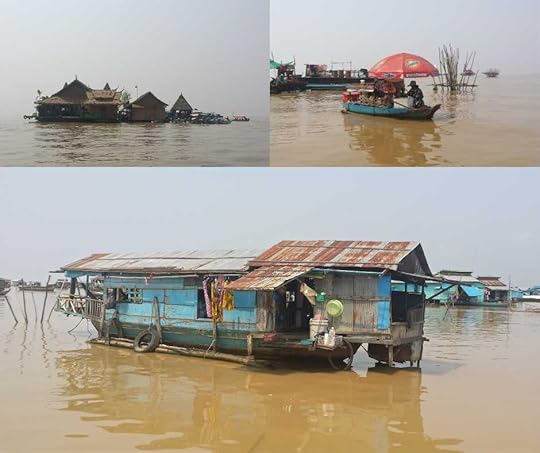
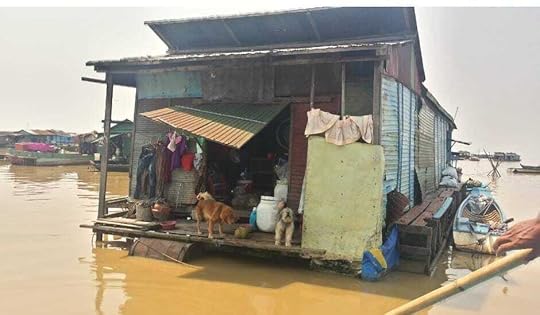
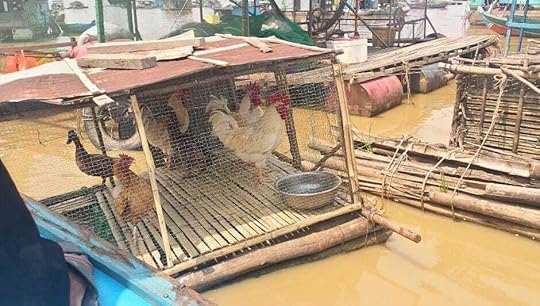
I saw a woman in a canoe with a large basket of white eggs.
Our boat driver bought some eggs from her and I learned they were crocodile eggs!
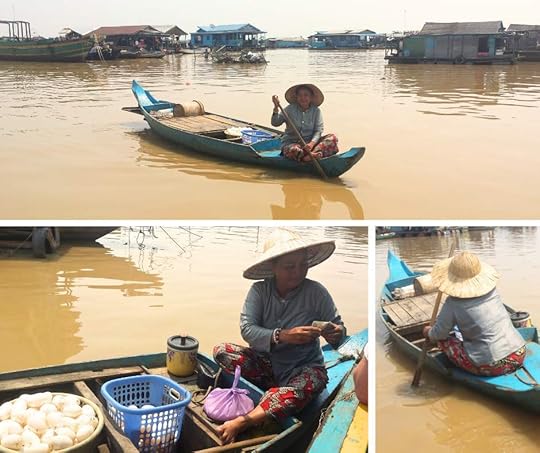
Later, in the middle of the lake, we got off the boat onto a large floating raft.
We saw a few (captive) crocodiles wallowing in muddy water, we bought a beer and then took some time to look around us at the watery world of Tonle Sap Lake, and the floating villages and all the lake-dwelling people going about their daily business.
Visiting the floating village was a fascinating and a wonderfully immersive experience.
I would absolutely recommend this trip to you, if you are looking for a half day trip out of Siem Reap, and some respite from temple bagging!
I particularly enjoyed being on a private trip with local people and not on one of the larger group tour trips on the bigger boats that we saw on the lake.
There are lots of different trips on offer to take you to the floating villages on Tonle Sap Lake.
So be sure to book the one that suits you best.
And take some one dollar bills with you for the local children with the photogenic snakes!
 Taking time to look around at the watery world of Tonle Sap Lake Floating VillageTHE BEST TIME TO VISIT CAMBODIA
Taking time to look around at the watery world of Tonle Sap Lake Floating VillageTHE BEST TIME TO VISIT CAMBODIAThe best time to visit the floating villages on Tonle Sap Lake in Cambodia is typically during the dry season, which runs from November to April.
Daytime temperatures at this time of year are usually around 25°C to 30°C (77°F to 86°F).
My visit to the floating village was at the beginning of April. During this time, water levels are lower, making it easier for boats and tours to navigate through the villages and explore the surroundings.
Additionally, the weather tends to be more pleasant with less rainfall, allowing for a more enjoyable experience.
However, it’s also worth noting that visiting during the wet season can provide a different perspective as water levels rise, offering a unique insight into the lifestyle of the people living in these floating communities.
So, the best time to visit, depends on what kind of experience you’re seeking.
Have you ever been to Cambodia?
Is Cambodia on your travel wish list?
Let me know. I’d love to hear from you.
Leave a comment in the box below!
 Klook.com (function (d, sc, u) { var s = d.createElement(sc), p = d.getElementsByTagName(sc)[0]; s.type = "text/javascript"; s.async = true; s.src = u; p.parentNode.insertBefore(s, p); })( document, "script", "https://affiliate.klook.com/widget/fe..." );
Klook.com (function (d, sc, u) { var s = d.createElement(sc), p = d.getElementsByTagName(sc)[0]; s.type = "text/javascript"; s.async = true; s.src = u; p.parentNode.insertBefore(s, p); })( document, "script", "https://affiliate.klook.com/widget/fe..." );I use and recommend Booking Dotcom to you
The post Cambodia: Tonle Sap Lake – Floating Village appeared first on The Backpacking Housewife.
April 28, 2024
Cambodia: Angkor Wat and Angkor Archaeological Park
Exploring Angkor Wat – one of the most important archaeological sites in Southeast Asia – and the temples and shrines at Angkor Archaeological Park has always been big on my travel wish list.
So, when the backpacking husband and were travelling in Asia and we had the opportunity to travel to Cambodia on a ‘visa run’ from Thailand, we flew into Cambodia’s northern province of Siem Reap.
Siem Reap is the gateway to The UNESCO Angkor Archaeological Park.
I was excited for the trip and in great anticipation of not only a ‘tomb raider’ style adventure exploring the many temples and shrines in the Angkor Archaeological Park.
I was also looking forward to having a spiritual appreciation of what is after all the largest religious monument in the world.
I do love exploring ancient temples having experienced many while travelling in Thailand – and as readers of my (affiliate link to Amazon) Backpacking Housewife Books already know – I’m always happy to receive a blessing from a monk!
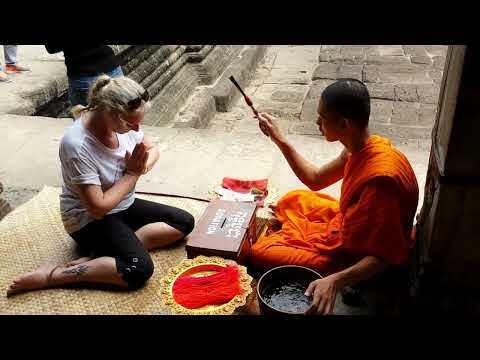
Short Video Clip: Being Blessed by a Monk at Angkor Wat CambodiaA THOUSAND BUDDHIST AND HINDU TEMPLES AND SHRINES
It is said there are around a thousand ancient Buddhist and Hindu temples and shrines from the era of the Khmer Empire (9th to the 15th centuries) in the area that have been reclaimed from the jungles of the surrounding area.
These include the famous Temple of Angkor Wat and, ‘The Great City’ and centrepiece at Angkor Thom with the magnificent Bayon ‘Temple of Faces’.
We planned to spend five days in Cambodia and three of those days exploring Angkor Wat and the Angkor Archaeological Park.
As we happened to be in Siem Reap in early April – when April and May are the hottest months in Cambodia and temperatures are often around 40 degrees C – we planned to spend two days at the hotel pool and spa.


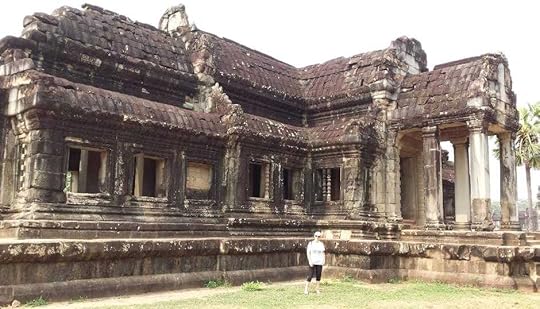 WHERE TO STAY IN SIEM REAP CAMBODIA
WHERE TO STAY IN SIEM REAP CAMBODIAWe decided to stay at a hotel a travel friend had recommended to us in Siem Reap.
We stayed at Memoire d’Angkor Boutique Hotel and we booked using (affiliate link) Booking Dotcom.
Our room was clean and comfortable and the hotel is in a great location. There was always a tuktuk waiting outside to take you anywhere you want to go and that’s how we found our wonderful driver for the days we wanted to explore the park.
I recommend that, like us, you get yourself a tuktuk driver for each of your exploration days and keep your walking confined to around the temples. You will find your tuktuk driver so affordable that you’ll want to tip him/her handsomely.
Your driver should first take you to the official ticket office where you can buy the tickets you need to explore Angkor Wat and the Angkor Archaeological Park.
NOTE: You can only buy your tickets from the Angkor Ticket Office (Angkor Enterprise) and any tickets bought anywhere else will be invalid.
You can get a one day, a three day, or a seven day pass.
We bought a three day pass at (price at time of writing) $62 USD each.
 We hired a tuktuk driver for each day exploring the Angkor Archaeological Park
We hired a tuktuk driver for each day exploring the Angkor Archaeological ParkYou should not underestimate how large the Angkor Archaeological Park is because it is a VAST area spread over four hundred sq/km of mostly jungle terrain.
Not sure how to imagine 400 sq/km?
Well, I’m from Scotland and the whole of Edinburgh, Scotland’s capital, only measures 264 sq/km.
If you are from the USA, as a comparison, Disney World in Florida is only 101 sq/km.
So, you get the gist, Angkor Wat and The Angkor Archaeological Park is HUGE.
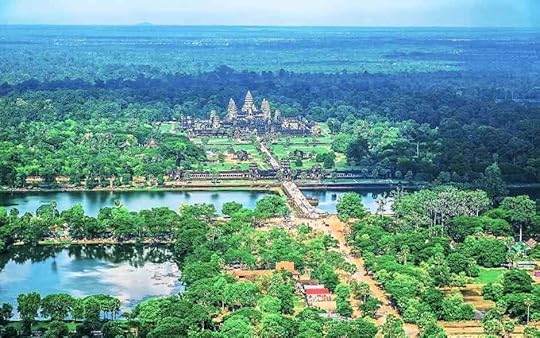 HOW MANY DAYS TO EXPLORE ANGKOR WAT AND ANGKOR ARCHAEOLOGICAL PARK?
HOW MANY DAYS TO EXPLORE ANGKOR WAT AND ANGKOR ARCHAEOLOGICAL PARK?You certainly need to allocate at least one whole day just for exploring Angkor Wat.
Then, there’s the vast ancient walled ruined city of Angkor Thon, for which I would allow at least another full day.
Then there’s the incredible Ta Thom Temple – of Tomb Raider fame – which is located outside the walls of the larger sites and in the midst of steamy jungle.
Okay – let’s go tomb raiding!
Travel with me to the awesome Angkor Archaeological Park!
THE TEMPLE OF ANGKOR WAT Angkor Wat is the largest religious monument in the world
Angkor Wat is the largest religious monument in the worldI think it’s useful and interesting to know a little about the place you are visiting and the first thing is to appreciate that Angkor Wat is the largest religious monument in the world.
In 2023 Angkor Wat officially became a Wonder of the World.
The temple’s layout is precisely oriented to the west and is also aligned with the spring equinox. The dimensions of its architectural elements are thought to be cosmologically significant to represent an earthly model of the universe.
The temple’s stone hallways are decorated with the longest continuous bas-relief sculptures and carvings in the world to include the famous scene of Churning of the Ocean of Milk from Hindu mythology.
Although the temple was originally constructed as a Hindu temple dedicated to Vishnu, Angkor Wat gradually transformed into a Buddhist temple.
Angkor Wat is now the most famous icon of Cambodia.
It is depicted on its national flag and is the country’s top tourist attraction.
THE CITY OF ANGKOR THOMThe ancient ‘Great City’ of Angkor Thom is set in a square site with a high wall and a moat. An entry tower and a small temple known as “Prasat Chrung” which has a lotus shaped top stands at each corner of the wall.
The South Gate of the Great City also embraces the religious significance with carvings again depicting faces and elements of Buddhism and Hinduism.
A serpent spreads its nine heads in the shape of a fan at the beginning of the long causeway, which is lined by a row of mythical stone figures representing demons on the right side and deities on the left, that lead to each entry tower.
These figures of over one hundred beings guard and protect Angkor Thom.
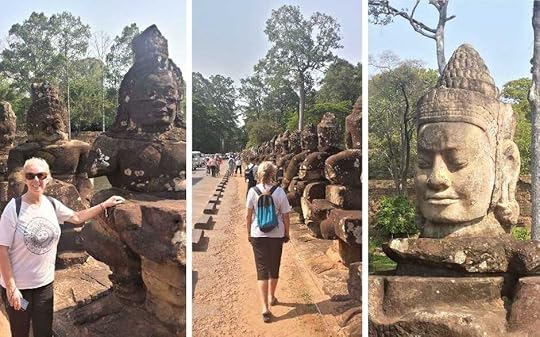 The Causeway of DeitiesTHE TEMPLES OF ANGKOR THOM
The Causeway of DeitiesTHE TEMPLES OF ANGKOR THOMThere are seventy-two temples and shrines within the Angkor Thom complex and, of course, without several months to spend ‘temple bagging’ you’d need to trust your research or preference or the recommendations of your tuktuk driver or temple guide to pick and choose the ones to visit during your visit.
Depending on the time of day and indeed the time of year, the Angkor Archaeological Park will be busy with tourists, so patience is a must when waiting to climb steps and in snapping photos for your social media or blog.
Luckily, as April is very much the hot season, we had a lot of the smaller temples and shrines at Angkor Thom to ourselves.
 In awe at experiencing Angkor Wat
In awe at experiencing Angkor Wat Stone hallways with the longest continuous bas-relief carvings in the world
Stone hallways with the longest continuous bas-relief carvings in the world We had a lot of the smaller temples and shrines to ourselves
We had a lot of the smaller temples and shrines to ourselvesThese are some of the temples I explored at Angkor Thom.
Ta Phrom: The jungle temple of Ta Phrom is famous as a location in the Tomb Raider movie starring Angelina Jolie. It was built in the mid-12th century by King Jayavarman VII and dedicated to his dear mother.
Ta Phrom has been left in its natural state and, to this day looks to be held in a dense jungle stranglehold by the giant roots of fig, banyan, and kapok trees.
It is a truly amazing experience to sit amongst the ruins of this temple and see all these long established tree roots twisted around the ancient stones and giant branches like limbs climbing over the roof structures.
It’s also incredible sight to see carved stone faces enveloped peeking out at you from the jungle foliage.

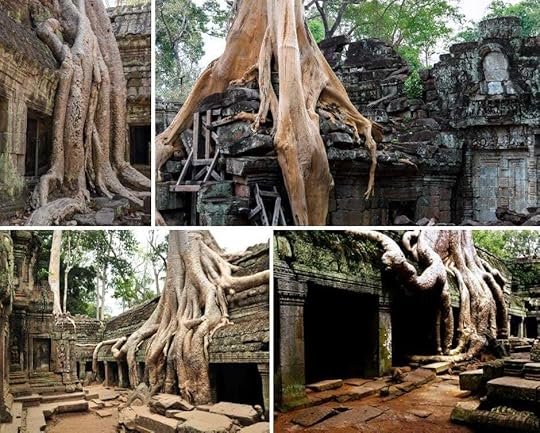
 Ta Phrom ‘the Tomb Raider’ Temple
Ta Phrom ‘the Tomb Raider’ TempleBayon Temple: The Bayon Temple was built as the official state temple of the Mahayana Buddhist King and nearly 100 years after Angkor Wat. It is located in the exact centre of The Great City of Angkor Thom.
Over 2000 large faces carved on the Beyon Towers give this temple its imposing character and it is assumed that the four faces on each of the towers are images of the king.
The attributes of the king’s face – his broad forehead, his downcast eyes, flaring nostrils and his lips that curl upwards at the ends – reflect the ‘Smile of Angkor’.
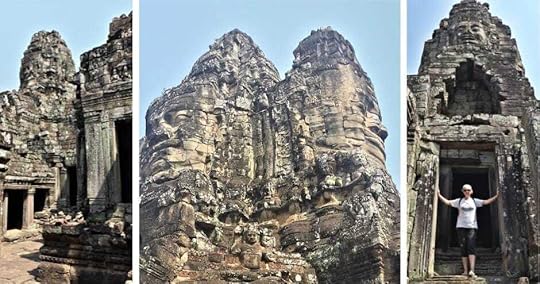
 The Bayon Temple
The Bayon TempleBaphuon Temple: The Baphuon Temple, built in the mid-11th century, it is a three-tiered ‘golden mountain’ temple with a steep staircase in pyramid style that is dedicated to the Hindu God Shiva.
The temple was also converted into a Buddhist temple in the late 15th Century.
A reclining Buddha that is nine meters tall and seventy meters long was added to the west side of the temple around this time.
This temple has been restored over the years by teams of dedicated archaeologists.
I found that the view from the top of the staircase is well worth the climb.

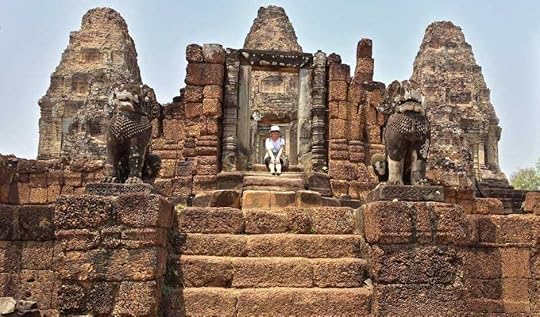
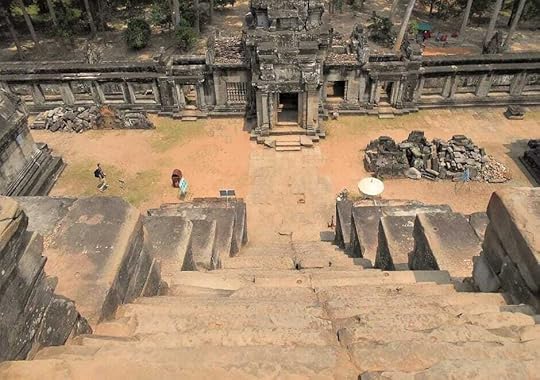 The Baphuon Temple
The Baphuon TempleTerrace of Elephants: The Terrace of Elephants was constructed in the late 12th century by King Jayavarman VII. The original structure was used as a viewing platform for the king to welcome home his victorious armies from battles and it can be found in the Royal Square of Angkor Thom.
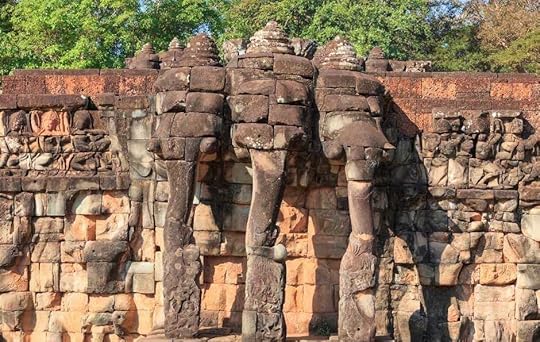
 The Terrace of ElephantsA CONCISE HISTORY OF THE KINGDOM OF ANGKOR
The Terrace of ElephantsA CONCISE HISTORY OF THE KINGDOM OF ANGKORI think it’s important to have a certain amount of knowledge about the historical sites you are visiting in order not only to fully appreciate them but to fix in your mind a timeline of the history in order to reflect on the perspective of time.
So, to save you the trouble of searching, I’ve included below a concise and interesting history and timeline of dates and facts that I have discovered and found fascinating about the ancient Kingdom of Angkor.
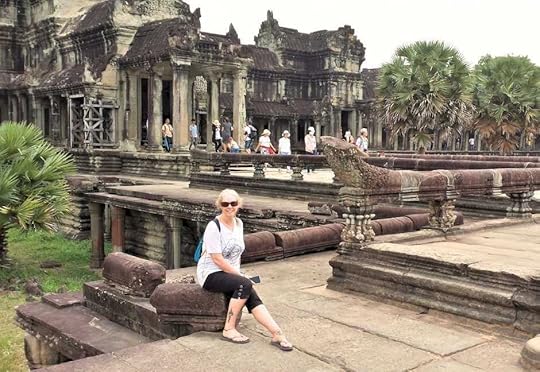 A TIMELINE OF DATES AND FACTS ON THE KINGDOM OF ANGKOR
A TIMELINE OF DATES AND FACTS ON THE KINGDOM OF ANGKORAround 800 AD a powerful regional king named Jayaraman II, who was considered divine and ‘God like’, founded the Kingdom of Angkor.
Three hundred years later, at the height of Angkor’s dominion over Southeast Asia between 1113 and 1150 AD, King Suryavarman II ruled and during his reign he ordered the construction of Angkor Wat as a shrine to the god Vishnu.
The other great king of Angkor was Jayaraman VII, who in 1181, initiated the building of The Temple City of Angkor Thom.
This temple city was enclosed by a square wall more than seven miles long and about 26 feet high. In its centre is the Bayon Temple with its 54 towers and carved into each of the tower’s four sides is a face.
Angkor’s temples were documented and partially restored in the 1850/60s by European explorers.
After the fall of the Khmer Rouge and the end of the Civil War in the 1980s, Angkor became a focal point of the rebuilding efforts in Cambodia.
Today, tourism generated by Angkor is a vital source of income but it must be noted that the millions of tourists who visit Angkor Archaeological Park each year do add to the escalating threat to the integrity of the temple structures and to the ecological balance of park itself.
This issue is an ongoing concern for UNESCO who in 2022 implemented a case study for sustainable tourism to protect local business and the integrity of this World Heritage Site.
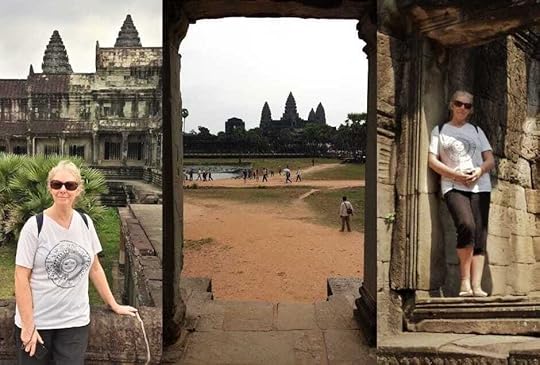 THE KINGDOM OF ANGKOR REDISCOVERED
THE KINGDOM OF ANGKOR REDISCOVEREDOver thousands of years, many adventurers, naturalists, and explorers have been credited with ‘rediscovering’ the Kingdom of Angkor. Yet, it is also assumed that Angkor Wat and the other Angkor Temples were being cared for by the Buddhist monks, who are credited for keeping them reasonably intact throughout history.
During the 15th and 16th centuries various Spanish missionaries left reports about their visits.
In the mid-16th century, while hunting elephants, the Portuguese Diego de Couto described coming across temples and city ruins.
In 1603 the Spaniard Gabriel Quiroga wrote: “In 1507 a city was brought to light that had never been seen or heard of by the natives”.
In 1632, Japanese writings were found on a pillar in Angkor Wat and sometime between 1632 and 1636 another Japanese man, Kenryo Shimano, drew a very detailed map of the temple.
In the 16th century a Khmer court returned briefly to Angkor to restore it as a Buddhist shrine
Then, in 1860, a Frenchman, Henri Mouhot, with the help of French missionary Father Charles-Émile Bouillevaux, was famously credited with the discovery of the “lost city of Angkor” on the publication of his travel journal.
Mouhot’s journal was published in 1863, two years after his death at the age of 35, and it made him posthumously famous.
He told the world of a great temple lost and then consumed by the jungle in deepest Cambodia. His descriptions were excitingly romantic and adventurous.
He said “One of these temples, a rival to that of Solomon, and erected by some ancient Michelangelo, might take an honourable place beside our most beautiful buildings. It is grander than anything left to us by Greece or Rome”.
I can only imagine the scene back then when stone statues of deities and the faces of sculptures peeped out from branches and vines and creepers to hint at the ancient long lost wonder that lay all around.
You can certainly get a sense of this wonder when visiting Ta Prohm Temple with its invasion of giant trees and twisted roots that are wrapped around centuries old stones.
 TIPS ON WHAT TO WEAR AT THE ANGKOR ARCHAEOLOGICAL PARK
TIPS ON WHAT TO WEAR AT THE ANGKOR ARCHAEOLOGICAL PARKCambodia is a conservative country and all the temples are important religious sites so you should dress respectfully or you will be refused entry.
I suggest you wear a cotton shirt that covers your shoulders and your upper arms and a light skirt or long trousers or capri pants that will cover your knees.
I recommend sturdy comfortable shoes for walking and for climbing steps and tackling uneven ground.
I also recommend wearing a sun hat and sunscreen protection.
I would also advise you to wear an insect repellent and whatever season you visit Angkor Archaeological Park you should carry a water bottle and avoid getting overheated and dehydrated.
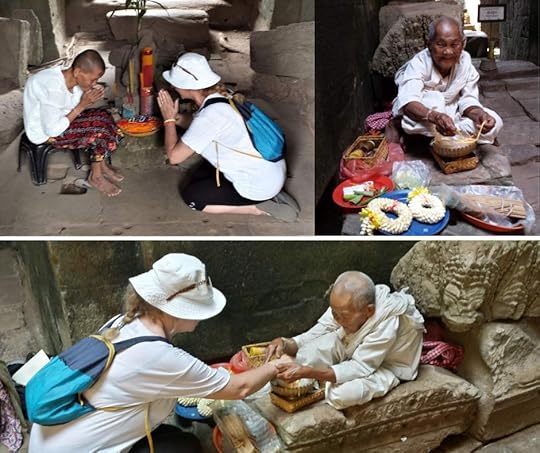 Receiving blessings and a ‘sai sin’ string cord at Angkor WatTHE BEST TIME TO VISIT ANGKOR ARCHAEOLOGICAL PARK
Receiving blessings and a ‘sai sin’ string cord at Angkor WatTHE BEST TIME TO VISIT ANGKOR ARCHAEOLOGICAL PARKThe best time to visit the Angkor Archaeological Park in Siem Reap, Cambodia, is generally during the cool and dry season from November to February when the weather is cooler, making it ideal for exploring the temples of Angkor Wat and other outdoor activities. The daytime temps during this period usually hover around 25°C to 30°C (77°F to 86°F).
Cool and Dry Season (November to February): This is the peak tourist season due to the favourable weather conditions. It’s also a great time for photography as the skies are clear and the light is good for capturing the ancient ruins.
Hot Season (March to May): Temperatures can soar up to 40°C (104°F) during these months. While this is still a popular time to visit, the heat can be quite intense, especially midday. If you visit during this time, plan early morning and late afternoon tours to avoid the hottest parts of the day.
Wet Season (June to October): This is the monsoon season when rainfall is frequent, especially in the afternoons. The advantage of visiting during this period is that the landscape is lush and green, and the tourist crowds are thinner.
Each season has advantages and disadvantages. So, the best time for your visit may depend on your own preferences for weather, crowd sizes, and landscape aesthetics.
 Another photo and posing opportunity at Angkor Wat
Another photo and posing opportunity at Angkor WatHave you visited Angkor Archaeological Park?
Have you been elsewhere in Cambodia?
Is Angkor Wat on your travel wish list?
Let me know. I’d love to hear from you!
Leave a comment in box below.
 Klook.com (function (d, sc, u) { var s = d.createElement(sc), p = d.getElementsByTagName(sc)[0]; s.type = "text/javascript"; s.async = true; s.src = u; p.parentNode.insertBefore(s, p); })( document, "script", "https://affiliate.klook.com/widget/fe..." );
Klook.com (function (d, sc, u) { var s = d.createElement(sc), p = d.getElementsByTagName(sc)[0]; s.type = "text/javascript"; s.async = true; s.src = u; p.parentNode.insertBefore(s, p); })( document, "script", "https://affiliate.klook.com/widget/fe..." );The post Cambodia: Angkor Wat and Angkor Archaeological Park appeared first on The Backpacking Housewife.








